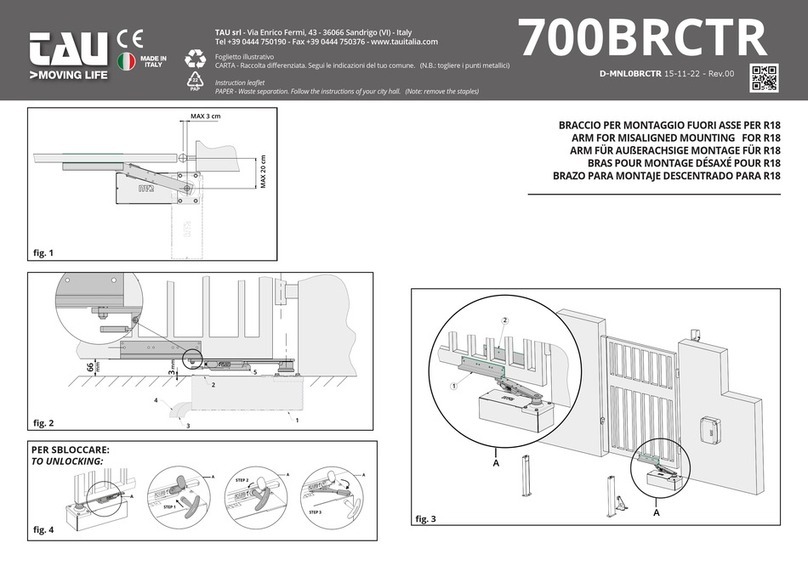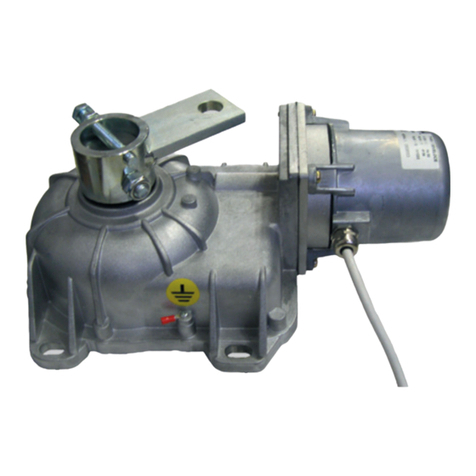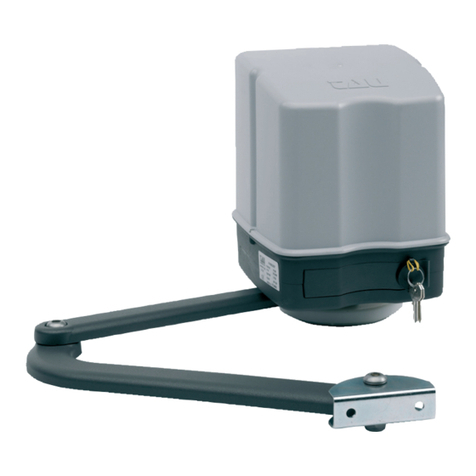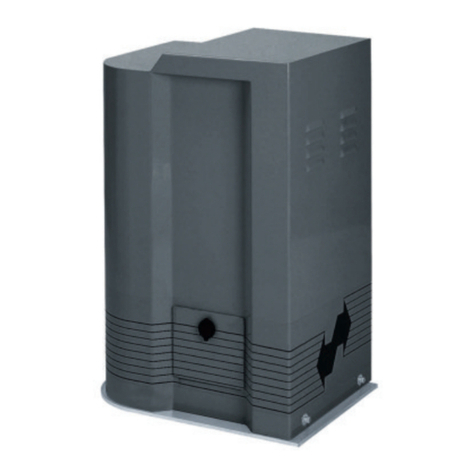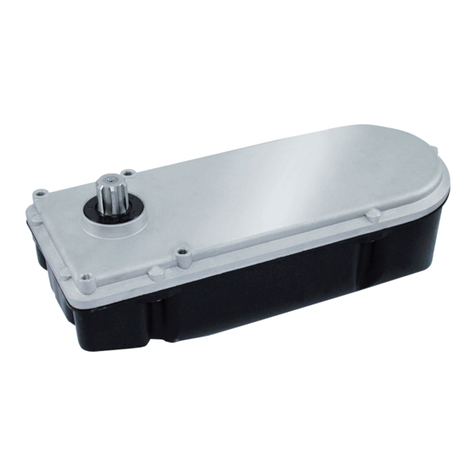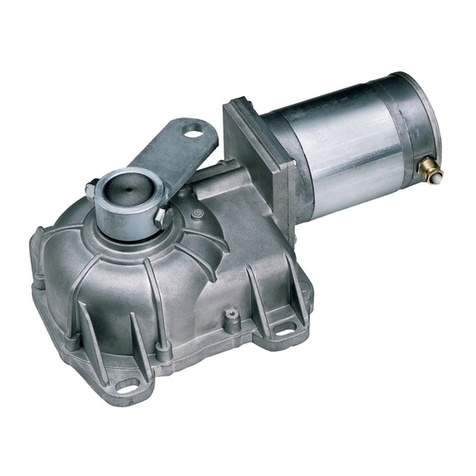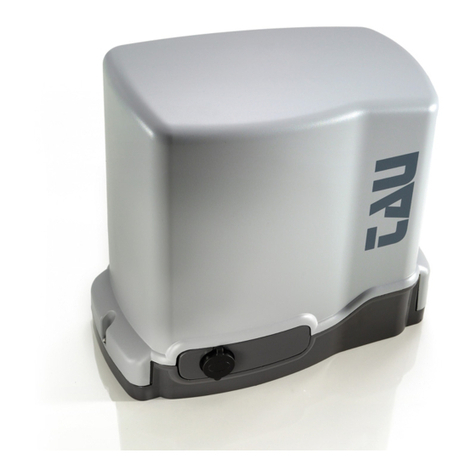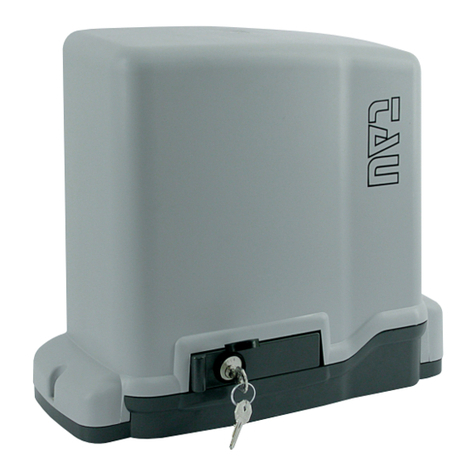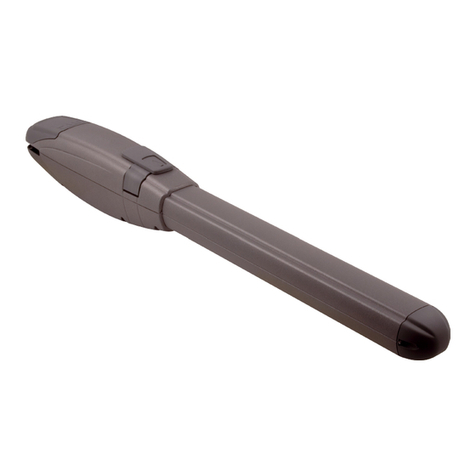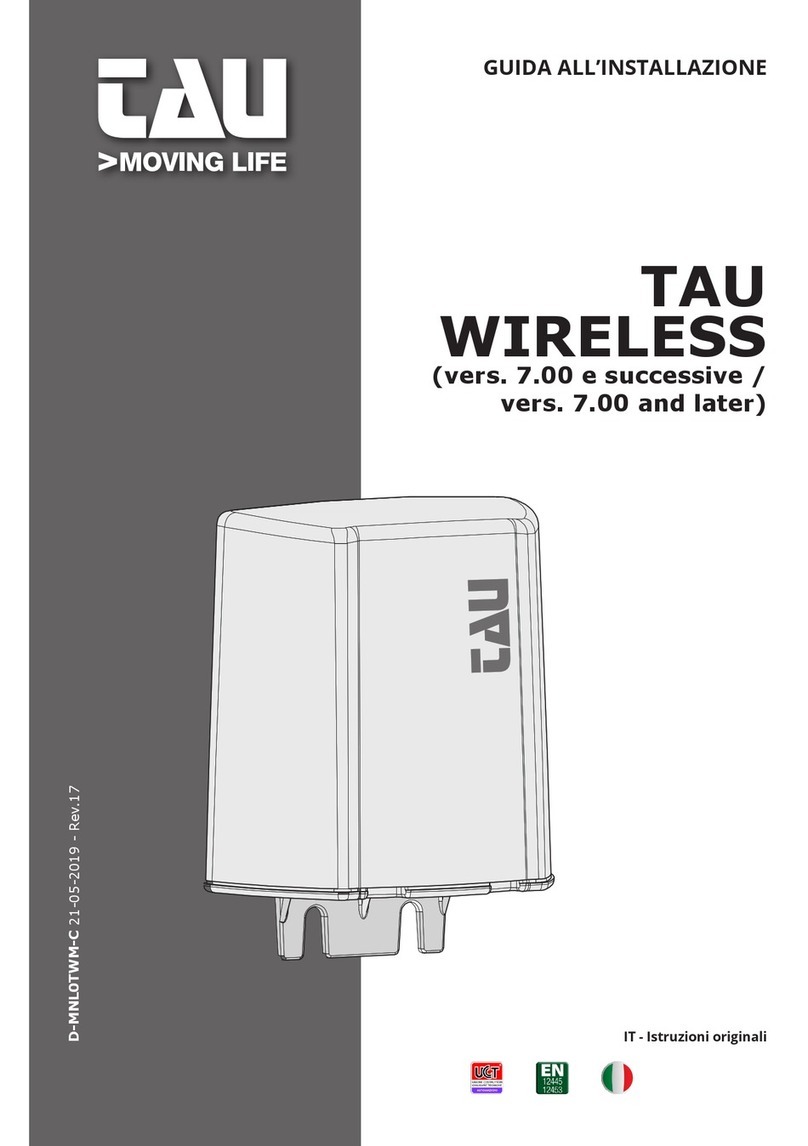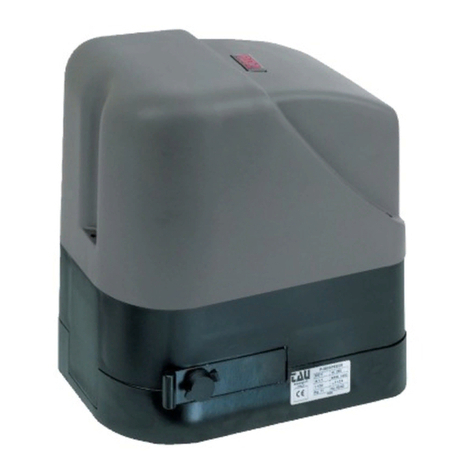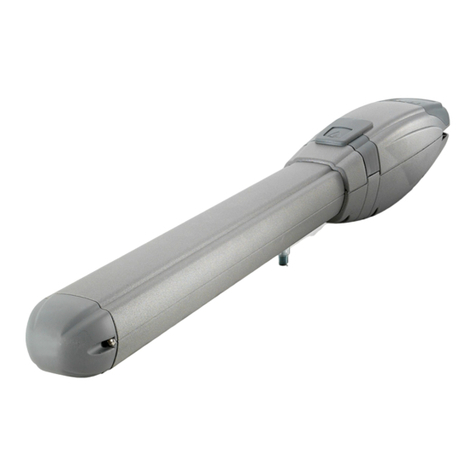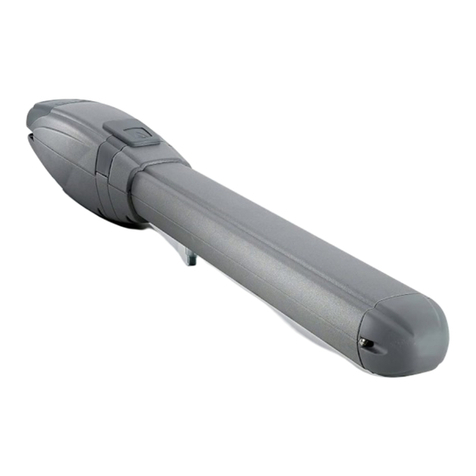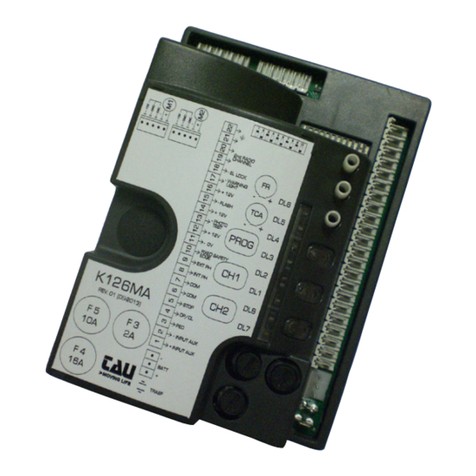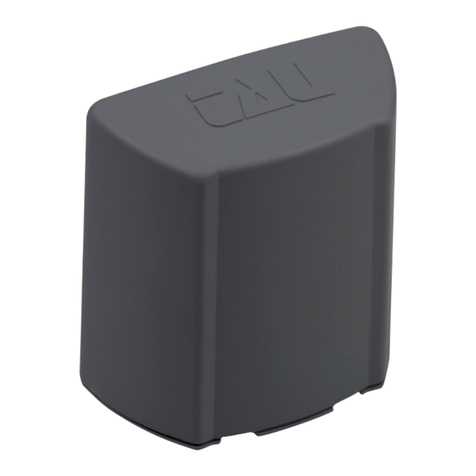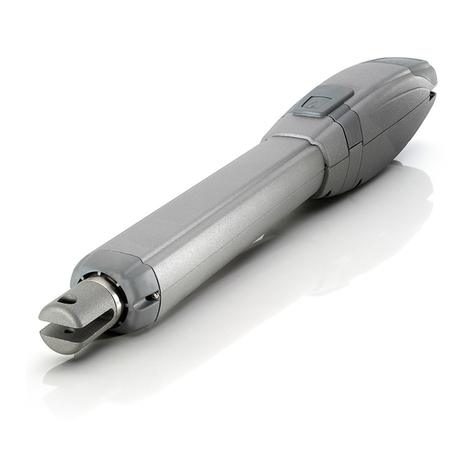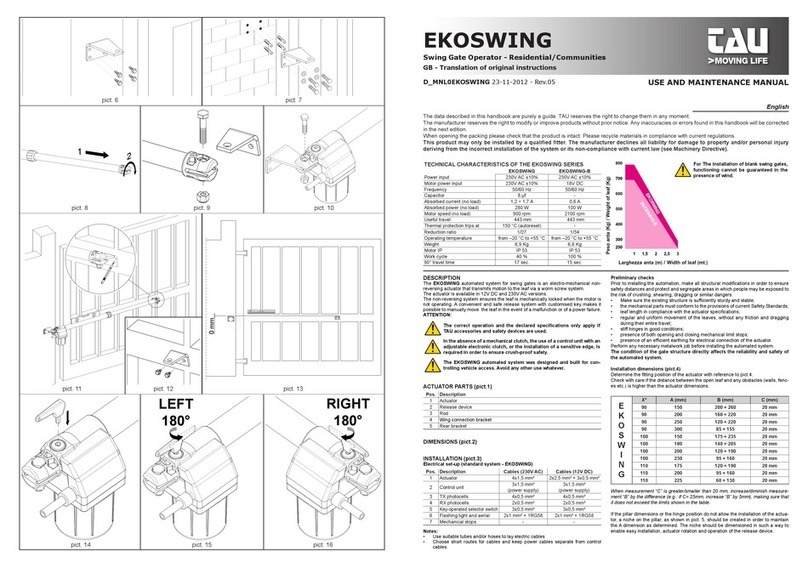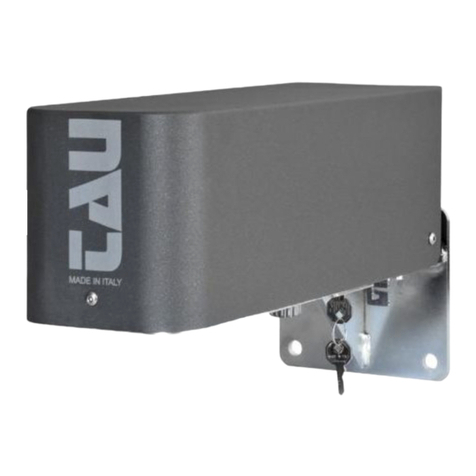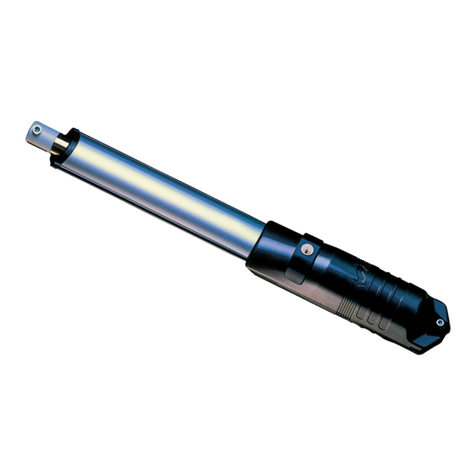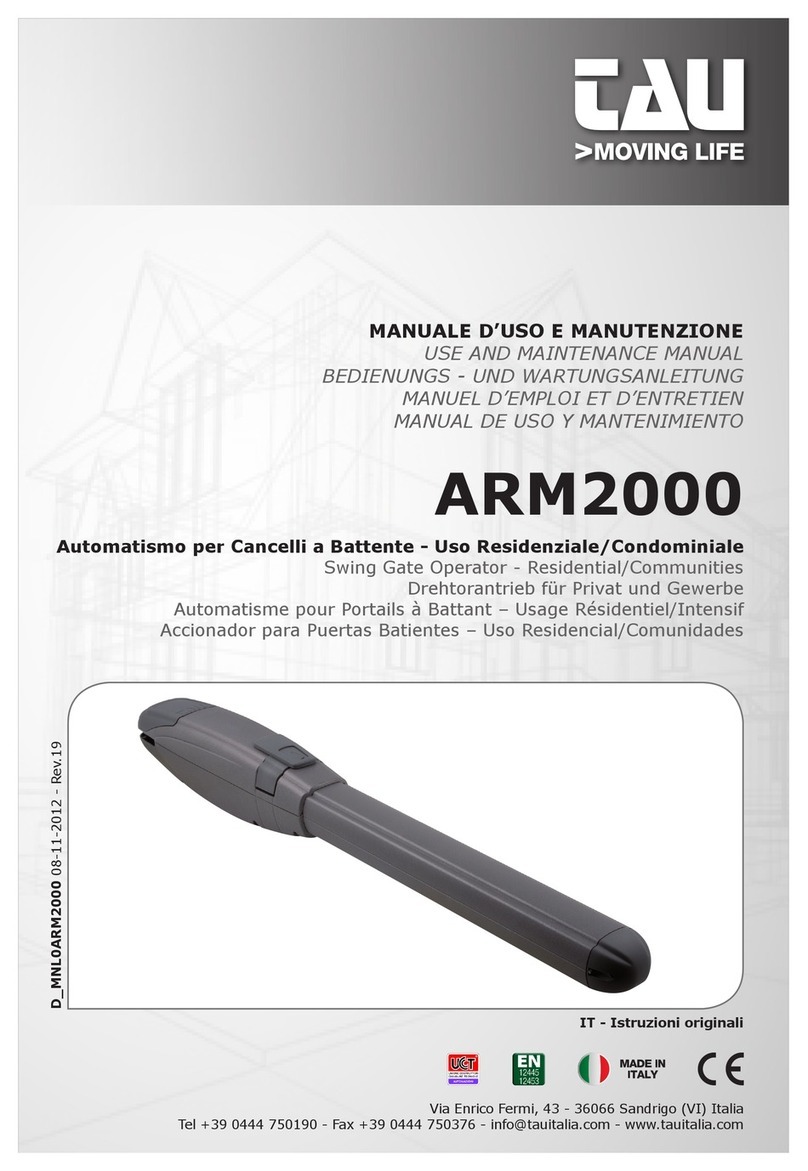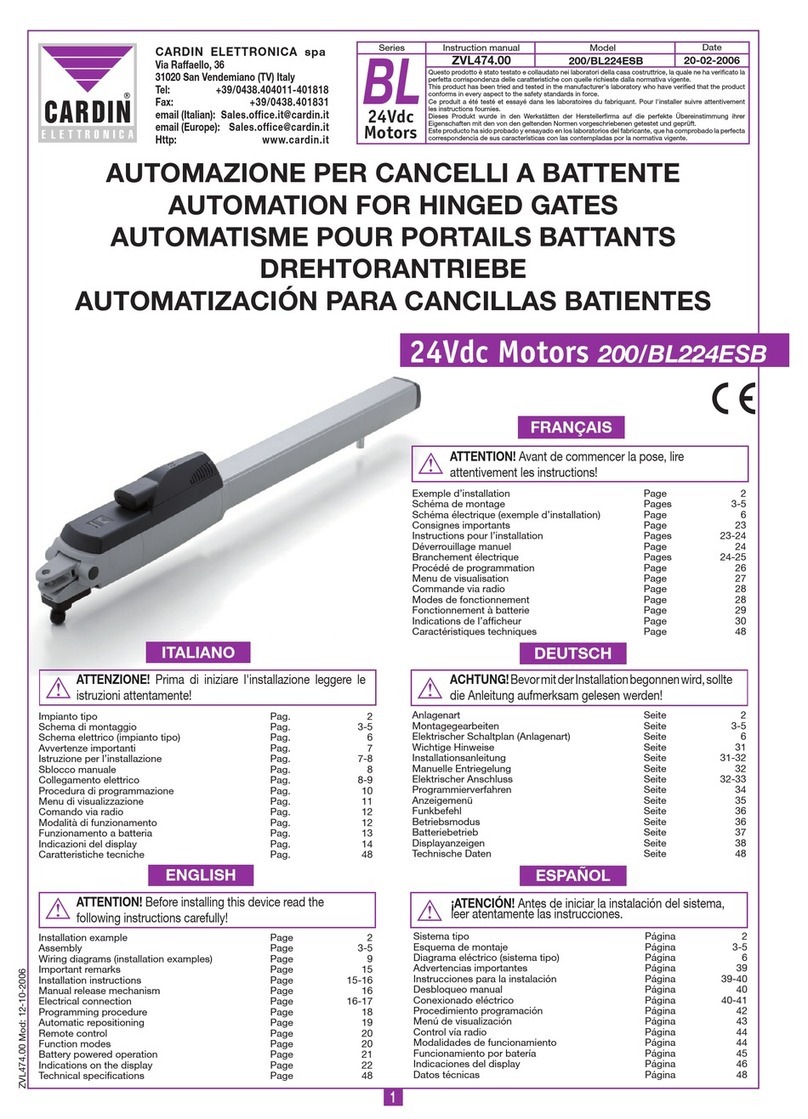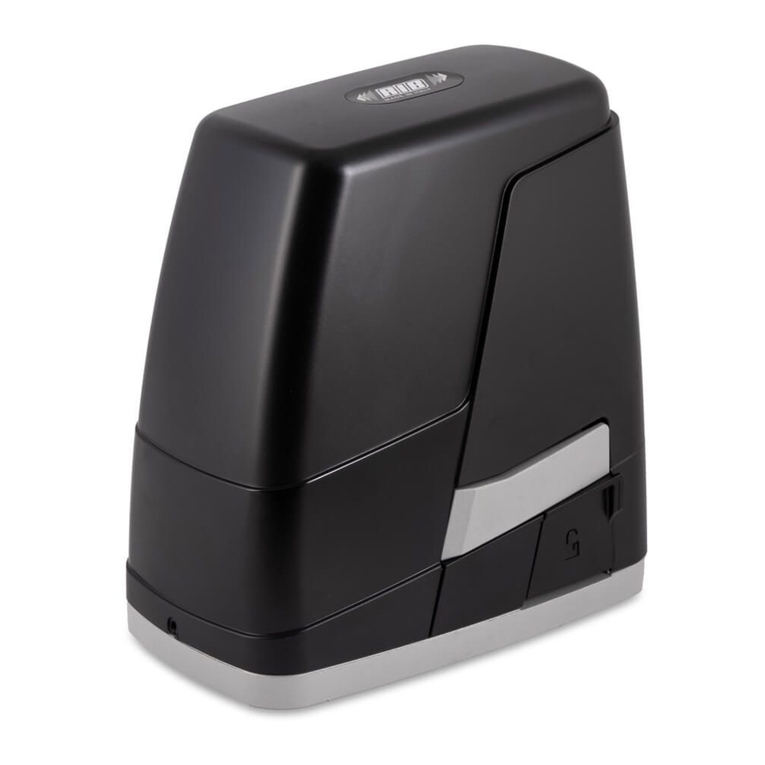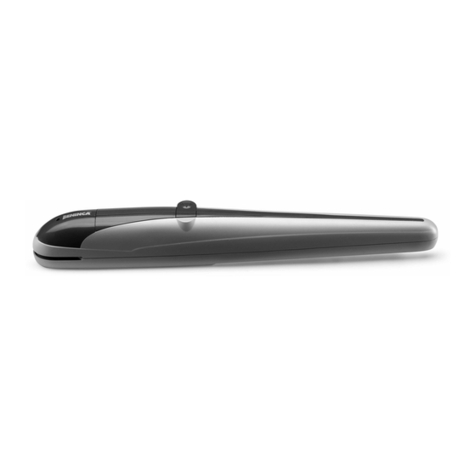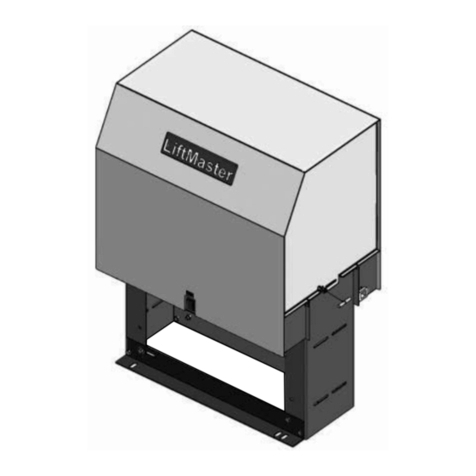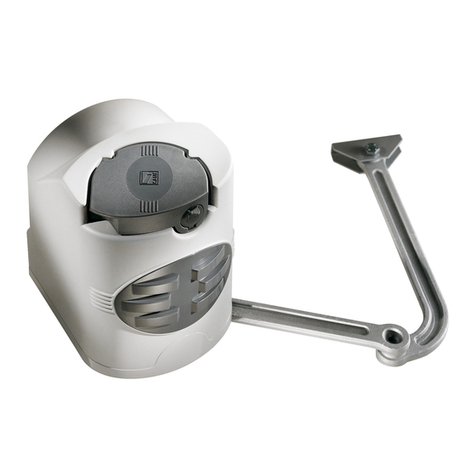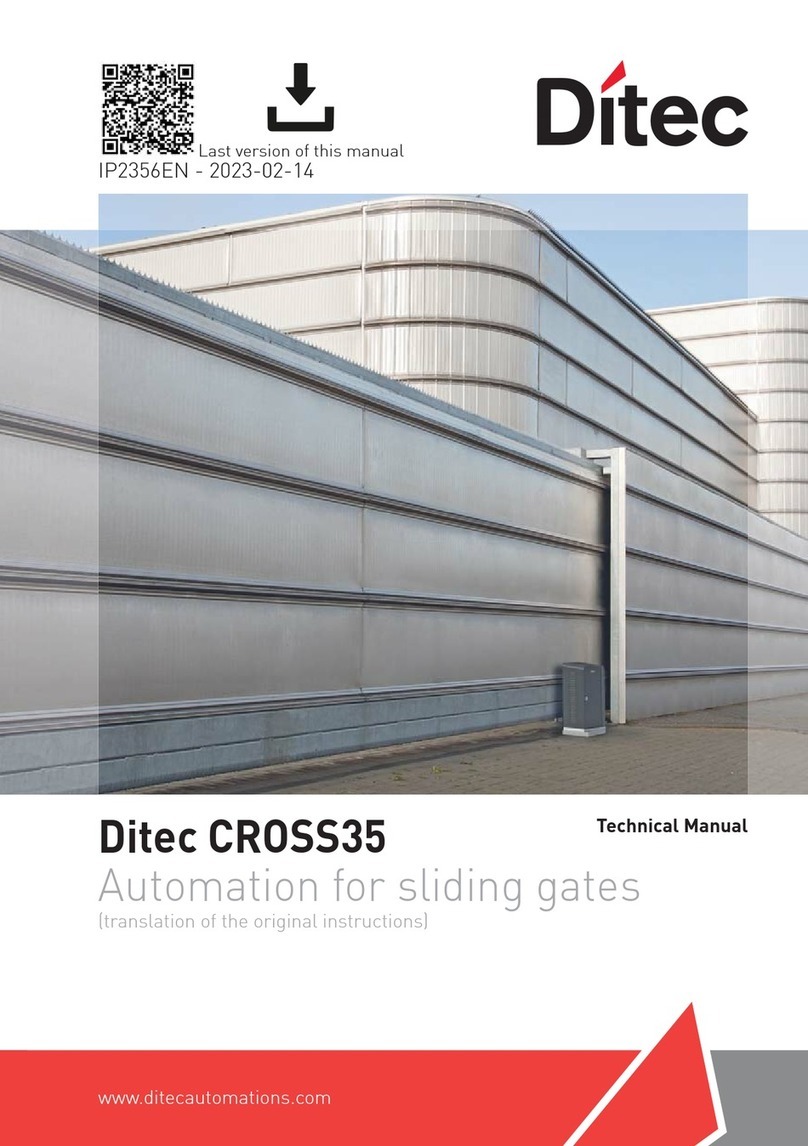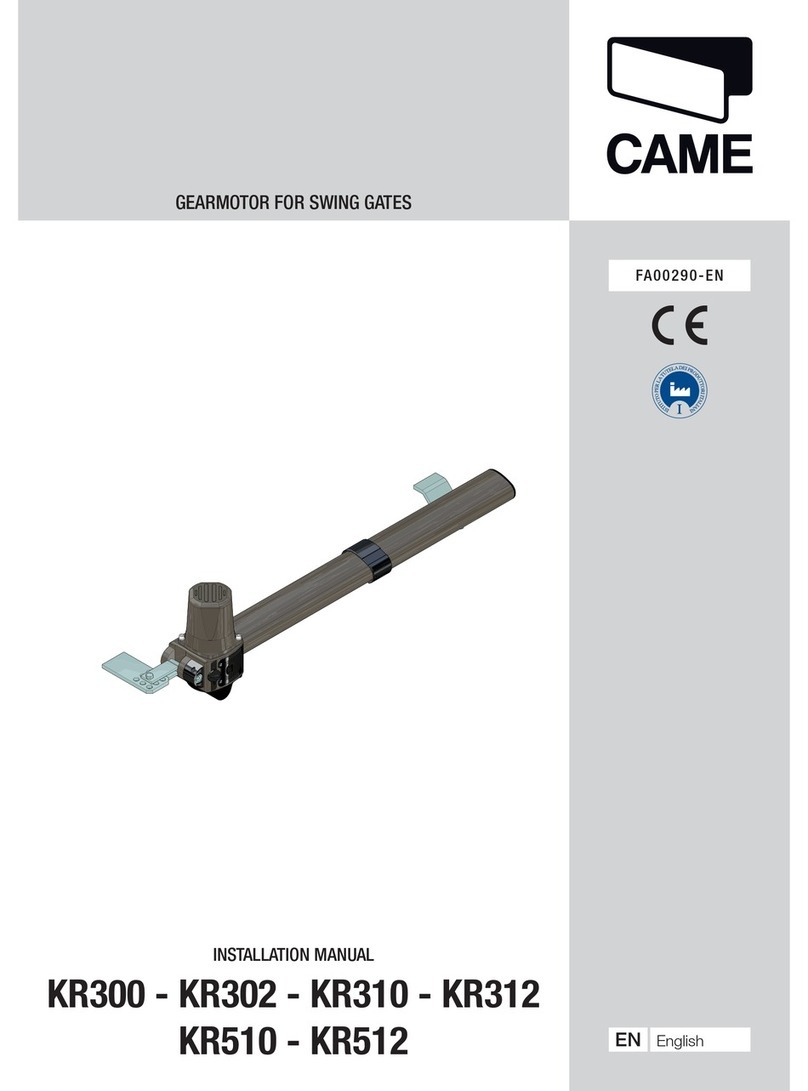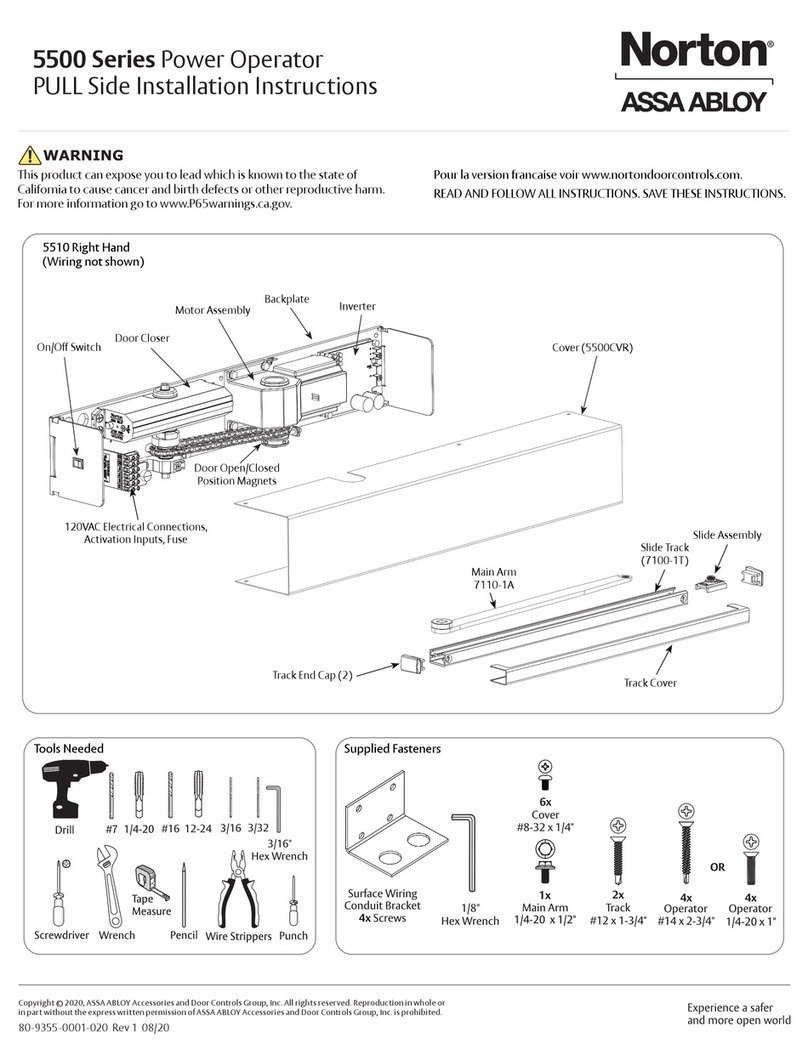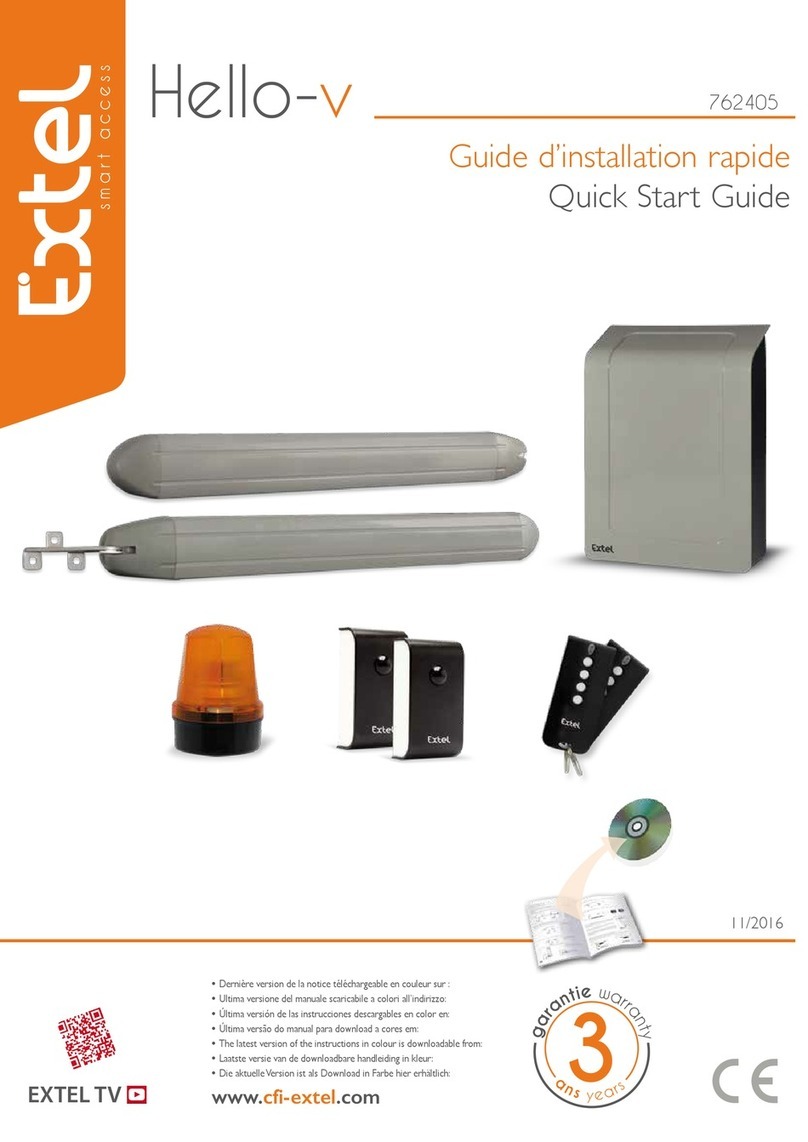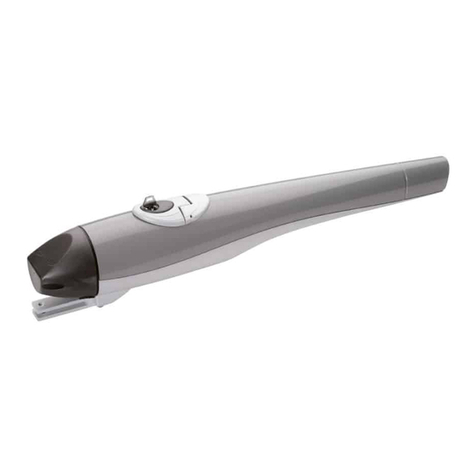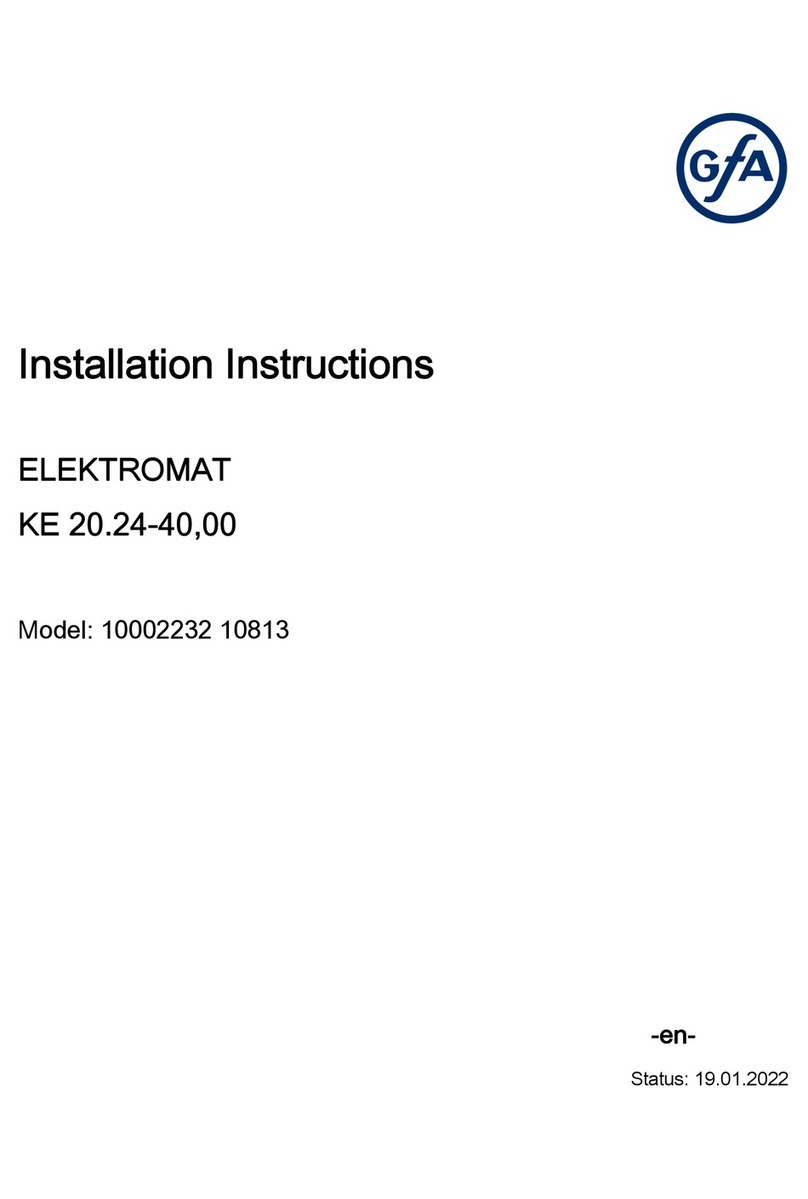tau BIG Series User manual

1
BIG Series
MANUALE D’USO E MANUTENZIONE
USE AND MAINTENANCE MANUAL
BEDIENUNGS - UND WARTUNGSANLEITUNG
MANUEL D’EMPLOI ET D’ENTRETIEN
MANUAL DE USO Y MANTENIMIENTO
BIG
Motoriduttore per cancelli scorrevoli ad uso industriale
Sliding Gate Operator – Industrial
Schiebetorantrieb für Gewerbe und Industrie
Automatisme pour Portails Coulissants – Usage Industriel
Accionador para Puertas Correderas – Uso Industrial
Via Enrico Fermi, 43 - 36066 Sandrigo (VI) Italia
Tel +39 0444 750190 - Fax +39 0444 750376 - info@tauitalia.com - www.tauitalia.com
IT - Istruzioni originali
D_MNL0BIG 26-07-2011 - Rev.12

2
BIG Series
Italiano
Español
English
Français
Deutsch
I dati riportati nel presente manuale sono puramente indicativi. La TAU si riserva il diritto di modicarli in qualsiasi momento.
La Casa costruttrice si riserva il diritto di apportare modiche o miglioramenti al prodotto senza alcun preavviso. Eventuali imprecisioni
o errori riscontrabili nel presente fascicolo, saranno corretti nella prossima edizione.
All’apertura dell’imballo vericare che il prodotto sia integro. Riciclare i materiali secondo la normativa vigente.
L’installazione del prodotto dovrà essere effettuata da personale qualicato. La Ditta costruttrice Tau declina ogni responsabilità
per danni derivanti a cose e/o persone dovuti ad un’eventuale errata installazione dell’impianto o la non messa a Norma dello
stesso secondo le vigenti Leggi (vedi Direttiva Macchine).
Los datos describidos en este manual son puramente indicativos. La TAU se reserva el derecho de modicarlos en cualquier
momento.
El Fabricante se reserva el derecho de modicar o actualizar el producto sin aviso previo. Posibles imprecisiones o errores en este
manual serán corregidos en la próxima edición.
Cuando abra el embalaje, controle que el producto esté íntegro. Recicle los materiales según la normativa vigente.
La instalación del producto tiene que ser efectuada por personal cualicado. El Fabricante Tau no se asume ninguna
responsabilidad por lesiones a personas o averías a cosas causadas por una instalación incorrecta del equipo o la por la
inobservancia de la normativa vigente (véase Directiva de Máquinas).
The data described in this handbook are purely a guide. TAU reserves the right to change them in any moment.
The manufacturer reserves the right to modify or improve products without prior notice. Any inaccuracies or errors found in this handbook
will be corrected in the next edition.
When opening the packing please check that the product is intact. Please recycle materials in compliance with current regulations.
This product may only be installed by a qualied tter. The manufacturer declines all liability for damage to property and/or
personal injury deriving from the incorrect installation of the system or its non-compliance with current law (see Machinery
Directive).
Les données décrites dans ce manual sont purement indicatives. La TAU se réserve le droit de les modier à n’importe quel moment.
Le Constructeur se réserve le droit d’apporter des modications ou des améliorations au produit sans aucun préavis. Les éventuelles
imprécisions ou erreurs présentes dans ce fascicule seront corrigées dans la prochaine édition.
À l’ouverture de l’emballage, vérier que le produit est intact. Recycler les matériaux suivant les normes en vigueur.
L’installation du produit devra être effectuée par du personnel qualié. Tau décline toute responsabilité pour les dommages
aux choses et/ou personnes dus à une éventuelle installation erronée de l’automatisme ou à la non-mise aux normes suivant
les lois en vigueur (voir Directive Machines).
Die beschriebenen Daten in der vorliegenden Betriebsanleitung sind rein indikativ. TAU behält sich vor, diese in jedem Moment zu
modizieren.
Der Hersteller behält sich das Recht vor, ohne vorherige Benachrichtung Änderungen oder Verbesserungen am Produkt anzubringen.
Ungenauigkeiten oder Fehler, die in der vorliegenden Ausgabe festgestellt werden, werden in der nächsten Ausgabe berichtigt.
Beim Öffnen der Verpackung prüfen, dass das Produkt keine Schäden aufweist. Die Materialien nach den gültigen Vorschriften
recyclen.
Die Installation des Produktes muss von Fachpersonal ausgeführt werden. Die Herstellerrma TAU übernimmt keinerlei
Haftung für Personen- und/oder Sachschäden aufgrund einer falschen Installation der Anlage oder der Nichtkonformität
derselben mit den gültigen Gesetzen (siehe Maschinenrichtlinie).

3
BIG Series
AVVERTENZE E ISTRUZIONI PER L’INSTALLATORE
Tau si congratula per la scelta del prodotto e vi invita a leggere con molta attenzione queste pagine.
Al ne di renderle semplici, le istruzioni sono state impaginate seguendo l’ordine delle varie fasi d’installazione dell’impianto.
Leggere attentamente le istruzioni prima di procedere all’installazione, in quanto forniscono importanti indicazioni concernenti
la sicurezza, l’installazione, l’uso e la manutenzione.
Tutto quello che non è espressamente previsto nel presente manuale NON è permesso. Consultare la TAU srl per ogni cosa non
indicata.
Usi non indicati, infatti, potrebbero essere causa di danni al prodotto stesso e mettere in pericolo persone, animali e/o cose.
L’installazione deve essere eseguita da personale qualicato, professionalmente competente.
L’installazione, i collegamenti elettrici e le regolazioni devono essere effettuati nell’osservanza della Buona Tecnica e in ottemperanza alle
norme vigenti.
Prima di iniziare l’installazione vericare l’integrità del prodotto.
Non installare il prodotto in ambiente e atmosfera esplosivi.
Prima di installare l’automazione, apportare tutte le modiche strutturali relative alla realizzazione dei franchi di sicurezza ed alla protezione
o segregazione di tutte le zone di schiacciamento, cesoiamento, convogliamento e di pericolo in genere. Vericare che la struttura esistente
abbia i necessari criteri di robustezza e stabilità. Per la messa a punto della coppia massima del motoriduttore, attenersi alle normative in
vigore (per l’Europa consultare le norme EN 12341-1 e EN 12635).
L’installazione del motoriduttore, ad eccezione dei modelli interrati, deve essere realizzata sopra il livello del pavimento, al ne di evitare
rischi di allagamento.
I dispositivi di sicurezza (fotocellule, coste sensibili, stop di emergenza, ecc.) devono essere installati tenendo in considerazione: le
normative e le direttive in vigore, i criteri della Buona Tecnica, l’ambiente di installazione, la logica di funzionamento del sistema e le forze
sviluppate dalla porta o cancello motorizzati.
Scegliere percorsi brevi per i cavi. Tenere separati i cavi di potenza dai cavi di comando.
Quantunque il motoriduttore possa essere dotato di tutti i dispositivi di sicurezza si consiglia caldamente di tenere fuori della portata di
bambini o di persone inabili ogni dispositivo in grado di comandare l’apertura del cancello e che possa inavvertitamente essere usato
senza sorveglianza.
Applicare le segnalazioni previste dalle norme vigenti per individuare le zone pericolose. Ogni installazione deve riportare in modo visibile
l’indicazione dei dati identicativi degli organi automatizzati.
Prima di collegare l’alimentazione elettrica accertarsi che i dati di targa siano rispondenti a quelli della rete di distribuzione elettrica.
Prevedere sulla rete di alimentazione un interruttore/sezionatore onnipolare con distanza d’apertura dei contatti uguale o superiore a 3
mm.
Vericare che a monte dell’impianto elettrico vi siano un interruttore differenziale e una protezione di sovracorrente adeguati (interruttore
magnetotermico C6).
Collegare l’automazione ad un efcace impianto di messa a terra eseguito come previsto dalle vigenti norme di sicurezza.
Il costruttore dell’automazione declina ogni responsabilità qualora vengano installati elementi incompatibili ai ni della sicurezza e del buon
funzionamento. Per l’eventuale riparazione o sostituzione dei prodotti, dovranno essere utilizzati esclusivamente ricambi originali.
L’installatore deve fornire tutte le informazioni relative al funzionamento automatico, manuale e di emergenza della struttura automatizzata,
e consegnare all’utilizzatore dell’impianto le istruzioni per l’uso.
Consigliamo di riporre tutta la documentazione relativa all’impianto all’interno o nelle immediate vicinanze della centralina.
Italiano
WARNINGS AND INSTRUCTIONS FOR FITTERS
Congratulations on choosing this Tau product. Please read this handbook carefully.
For the sake of simplicity, the instructions are listed in order of installation.
Please read these instructions carefully before installing the product as they contain important information concerning safety,
installation, use and maintenance.
Anything not expressly specied in this handbook is FORBIDDEN. Contact TAU srl for information regarding any points which may not
have been specied in the present manual.
Operations not indicated in these instructions may damage the product and put people, animals and/or and property at risk.
The equipment should be installed only by trained and qualied personnel.
Installation, electrical connections and adjustments must be made according to the rules of good workmanship and current standards.
Before beginning installation, make sure the product is undamaged.
Do not install the product in explosive environments.
Prior to installing the automation, make all structural modications in order to ensure safety distances and protect and segregate areas
in which people may be exposed to the risk of crushing, shearing, dragging or similar dangers. Make sure the existing structure is
sufciently sturdy and stable. Observe current legislation when adjusting maximum gearmotor torque (in Europe consult EN 12341-1
and EN 12635 standards).
Apart from buried models, the gearmotor must be installed above ground level in order to prevent damage deriving from ooding.
The safety devices (photocells, sensitive edges, emergency stop devices, etc.) must be installed according to current legislation and
directives, the rules of good workmanship, the installation area, the operating logic of the system and the forces developed by the
powered door or gate.
Choose short routes for the cables. Keep power cables separate from control cables.
Though the gearmotor is tted with various safety devices, we strongly recommend keeping all unattended devices capable of opening
the gate out of the reach of children or unable adults.
Fit the signs required by current regulations for identifying dangerous areas. Each installation must show the identication data of the
automated devices in a visible place.
Before connecting to the power supply, make sure the data on the rating plate correspond to the mains power supply.
Fit a multipole switch/knife switch on the power supply network with contacts opening distance of at least 3 mm.
Make sure there is a suitable circuit breaker and overcurrent protection device (thermal-magnet breaker C6) upline from the electrical
system.
Connect the automation to an efcient earth system compliant with current safety standards.
The manufacturer declines all liability if incompatible safety and components are installed. Only use original spare parts to repair or
replace the product.
The tter must provide all the information relative to the automatic, manual and emergency operation of the automated unit, and give
the user the operating instructions.
Keep all the documents concerning the system inside or near the central control unit.
English

4
BIG Series
AVERTISSEMENTS ET INSTRUCTIONS POUR L’INSTALLATEUR
Tau vous félicite de votre choix et vous invite à lire très attentivement les pages qui suivent.
An de faciliter la compréhension, l’ordre de présentation des instructions suit celui des différentes phases d’installation de l’automatisme.
Lire attentivement les instructions avant de procéder à l’installation, dans la mesure où elles fournissent des indications importantes
concernant la sécurité, l’installation, l’emploi et la maintenance.
Tout ce qui n’est pas expressément prévu dans ce manuel N’EST PAS permis. Consulter TAU srl pour tout ce qui n’est pas indiqué.
Les utilisations non indiquées, en effet, pourraient provoquer des dommages au produit et mettre en danger les personnes, les animaux et/ou
les choses.
L’installation doit être effectuée par du personnel qualié, professionnellement compétent.
L’installation, les connexions électriques et les réglages doivent être effectués dans les règles de l’art en respectant les normes en vigueur.
Avant de commencer l’installation, vérier l’intégrité du produit.
Ne pas installer le produit dans un environnement et une atmosphère explosifs.
Avant d’installer l’automatisme, apporter toutes les modications structurelles relatives à la réalisation des espaces de sécurité et à la
protection ou à l’isolement de toutes les zones d’écrasement, cisaillement et de danger en général. Vérier que la structure existante possède
la robustesse et la stabilité nécessaires.
Pour le réglage du couple maximum du motoréducteur, respecter les normes en vigueur (pour
l’Europe consulter les normes EN 12341-1 et EN 12635).
L’installation du motoréducteur, à l’exception des modèles enterrés, doit être réalisée au-dessus du niveau du sol an d’éviter les
risques d’inondation.
Les dispositifs de sécurité (photocellules, barres palpeuses, arrêt d’urgence, etc.) doivent être installés en tenant compte : des normes et des
directives en vigueur, des règles de l’art, du site d’installation, de la logique de fonctionnement du système et des forces générées par la porte
ou le portail motorisés.
Choisir des parcours brefs pour les câbles et maintenir les câbles de puissance séparés des câbles de commande.
Malgré tous les dispositifs de sécurité qui peuvent équiper l’automatisme, il est vivement conseillé de maintenir hors de portée des
enfants ou de personnes inaptes tout dispositif en mesure de commander l’ouverture du portail et qui, par mégarde, pourrait être
utilisé sans surveillance.
Appliquer les signalisations prévues par les normes en vigueur pour identier les zones dangereuses. Chaque installation doit reporter de
manière visible, l’indication des données d’identication des organes automatisés.
Avant de connecter l’alimentation électrique, s’assurer que les données de la plaque correspondent à celles du secteur de distribution électrique.
Prévoir sur le secteur d’alimentation un interrupteur/sectionneur omnipolaire avec distance d’ouverture des contacts égale ou supérieure à 3
mm.
Vérier qu’il y a en amont de l’automatisme un interrupteur différentiel et une protection contre la surcharge adéquats (interrupteur
magnétothermique C6).
Raccorder l’automatisme à une installation efcace de mise à la terre effectuée suivant les prescriptions des normes de sécurité en vigueur.
Le constructeur de l’automatisme décline toute responsabilité en cas d’installation de composants incompatibles en matière de sécurité et de
bon fonctionnement. Pour toute réparation ou pour tout remplacement des produits, il faudra utiliser exclusivement des pièces de rechange
originales.
L’installateur doit fournir toutes les informations relatives au fonctionnement automatique, manuel et d’urgence de la structure automatisée et
remettre à l’utilisateur de l’automatisme le mode d’emploi.
Nous conseillons de conserver toute la documentation relative à l’installation à l’intérieur de l’armoire de commande ou à proximité
immédiate.
Français
HINWEISE UND ANWEISUNGEN FÜR DEN INSTALLATEUR
Tau gratuliert Ihnen zur Wahl dieses Produkts und bittet Sie, diese Seiten sehr aufmerksam zu lesen.
Um die Anweisungen einfach zu machen, wurden sie in der Reihenfolge der verschiedenen Installationsphasen der Anlage verfasst.
Die Anweisungen vor der Installation genau lesen, da sie wichtige Hinweise mit Bezug auf Sicherheit, Installation, Bedienung und
Wartung liefern.
Alles nicht ausdrücklich in diesen Anleitungen vorgesehene ist UNZULÄSSIG. Wenden Sie sich für alles nicht angegebene an die Firma TAU
srl.
Ein nicht angegebener Gebrauch könnte Schäden am Produkt verursachen und Personen, Tiere und/oder Gegenstände in Gefahr bringen.
Die Installation muss von beruich kompetentem Fachpersonal ausgeführt werden.
Installation, elektrische Anschlüsse und Einstellungen sind unter Beachtung der Fachtechnik und der gültigen Vorschriften auszuführen.
Das Produkt vor der Installation auf Schäden überprüfen.
Das Produkt nicht in EX-Umgebung bzw. EX-Atmosphäre installieren.
Vor der Installation der Automatisierung alle strukturellen Änderungen für das Vorhandensein der Sicherheitsabstände und den Schutz aller
Bereiche ausführen, in denen Quetsch-, Schnitt- und Mitnehmgefahr und Gefahren allgemein bestehen. Prüfen, ob die vorhandene Struktur
die erforderliche Robustheit und Stabilität besitzt.
Für die Einstellung des maximalen Drehmoments des Getriebemotors sind die gültigen
Vorschriften zu beachten (für Europa siehe die Normen EN 12341-1 und EN 12635).
Die Installation des Getriebemotors muss, Unterurmodelle ausgenommen, über der Bodenhöhe erfolgen, um Überschwemmungsgefahr
zu vermeiden.
Sicherheitsvorrichtungen (Fotozellen, Sicherheitsleisten, Notstop usw.) müssen unter Berücksichtigung des folgenden installiert werden: gültige
Vorschriften und Verordnungen, korrekte Fachtechnik, Installationsumgebung, Betriebslogik des Systems und Kräfte, die vom motorbetriebenen
Tor entwickelt werden.
Kurze Strecken beim Verlegen der Kabel wählen. Leistungskabel von Steuerkabeln getrennt halten.
Auch wenn der Getriebemotor mit allen Sicherheitsvorrichtungen ausgestattet werden kann, empfehlen wir, Vorrichtungen zur Betätigung
eines Tors, die ohne Überwachung zufällig benutzt werden könnten, außer der Reichweite von Kindern oder Personen mit Handicaps
zu halten.
Zur Kennzeichnung von Gefahrenbereichen die laut gültigen Vorschriften vorgesehenen Beschilderungen anbringen. An jeder Installation
müssen die Kenndaten der automatisierten Elemente sichtbar angegeben sein.
Vor dem Anschluss der Stromversorgung ist sicher zu stellen, dass die Kenndaten mit jenen des Stromnetzes übereinstimmen.
Am Versorgungsnetz einen allpoligen Schalter/Trennschalter mit Öffnungsabstand der Kontakte von oder über 3 mm vorsehen.
Prüfen, dass vor der elektrischen Anlage ein Differentialschalter und ein geeigneter Überstromschutz (magnetothermischer Schalter C6)
vorhanden sind.
Die Automatisierung an eine wirksame Erdungsanlage anschließen, die nach den gültigen Sicherheitsvorschriften ausgeführt ist.
Der Hersteller der Automatisierung übernimmt keinerlei Haftung, falls Bestandteile installiert werden, die – was Sicherheit und korrekten Betrieb
betrifft – nicht kompatibel sind. Zur Reparatur oder zum Ersatz der Produkte dürfen ausschließlich Originalersatzteile verwendet werden.
Der Installateur hat alle Auskünfte über den automatischen und manuellen Betrieb und den Notbetrieb der automatisierten Struktur zu liefern
und muss dem Benutzer der Anlage die Bedienungsanweisungen aushändigen.
Wir empfehlen, alle Unterlagen der Anlage in der Steuerzentrale oder in ihrer unmittelbaren Nähe aufzubewahren.
Deutsch

5
BIG Series
ADVERTENCIAS E INSTRUCCIONES PARA EL INSTALADOR
Tau le agradece por la elección del producto y le invita a leer con mucha atención estas páginas.
A n de simplicar su uso, las instrucciones han sido compaginadas siguiendo el orden de las diferentes etapas de instalación del sistema.
Lea con atención las instrucciones antes de proceder con la instalación, puesto que suministran importantes indicaciones sobre la
seguridad, instalación, uso y mantenimiento.
Todo aquello que no está expresamente previsto en este manual NO está permitido. Consulte con TAU srl para cualquier cosa que no esté
indicada.
En efecto, los usos no previstos podrían causar averías al producto y ser peligrosos para las personas, animales o cosas.
La instalación debe ser hecha por personal cualicado y experto.
La instalación, las conexiones eléctricas y las regulaciones deben ser efectuadas correctamente y respetando las normas vigentes.
Antes de empezar la instalación, controle la integridad del producto.
No instale el producto en locales con atmósfera explosiva.
Antes de instalar la automatización, realice todas las modicaciones estructurales relativas a la realización de las distancias de seguridad y
a la protección o separación de todas las zonas de aplastamiento, corte y peligro en general. Controle que la estructura existente posea los
criterios necesarios de robustez y estabilidad.
Para poner a punto el par máximo del motorreductor, aténgase a las normativas en vigor
(para Europa consulte las normas EN 12341-1 y EN 12635).
La instalación del motorreductor, menos en el caso de los modelos enterrados, tiene que efectuarse por encima del nivel del
pavimento para evitar posibles inundaciones.
Los dispositivos de seguridad (fotocélulas, bordes sensibles, botón de parada de emergencia, etc.) se deben instalar teniendo en cuenta:
las normativas y directivas vigentes, los criterios de la buena técnica, el entorno de instalación, la lógica de funcionamiento del sistema y las
fuerzas desarrolladas por la puerta o cancela motorizadas.
Escoja recorridos cortos para los cables. Mantenga separados los cables de potencia de los cables de control.
Aunque el motorreductor disponga de todos los dispositivos de seguridad, se aconseja mantener fuera del alcance de los niños o de
personas incapacitadas cualquier dispositivo capaz de controlar la apertura de la cancela y que pueda utilizarse de forma inadvertida
sin vigilancia.
Aplique las señalizaciones previstas por las normas vigentes para señalar las zonas peligrosas. Cada instalación debe tener a la vista la
indicación de los datos de identicación de los componentes automatizados.
Antes de conectar la alimentación eléctrica, controle que las características nominales correspondan a aquellas de la red de distribución
eléctrica.
Prevea en la red de alimentación un interruptor omnipolar de 3 o más mm de apertura de los contactos.
Controle que antes de la instalación eléctrica haya un interruptor diferencial y un dispositivo de protección de sobrecorriente adecuados
(interruptor magnetotérmico C6).
Conecte la automatización a una instalación de puesta a tierra ecaz y que respete las normas de seguridad vigentes.
El fabricante de la automatización no se asume ninguna responsabilidad si se instalan componentes incompatibles para la seguridad y el
funcionamiento correcto. Para una posible reparación o sustitución de los productos, use sólo recambios originales.
El instalador debe suministrar todas las informaciones relativas al funcionamiento automático, manual y de emergencia de la estructura
automatizada, y entregar al usuario de la instalación las instrucciones para su uso.
Se aconseja guardar toda la documentación de la instalación en el interior o cerca de la central.
Español

6
BIG Series
Pag. 7 DESCRIZIONE, MODELLI E CARATTERISTICHE / DESCRIPTION, MODELS AND CHARACTERISTICS /
BASCHREIBUNG, MODELLE UND MERKMALE / DESCRIPTION, MODÈLES ET CARACTÉRISTIQUES /
DESCRIPCIÓN, MODELOS Y CARACTERÍSTICAS
Pag. 8 ITALIANO
Pag. 11 ENGLISH
Pag. 13 DISEGNI / DRAWINGS / ZEICHNEN / PROJETS / DIBUJOS
Pag. 18 DEUTSCH
Pag. 21 FRANÇAIS
Pag. 24 ESPAÑOL
Pag. 27 GARANZIA / GARANTIE / GUARANTEE / GARANTIE / GARANTÍA
INDICE
CONTENTS
VERZEICHNIS
INDEX
INDICE

7
BIG Series
DATI TECNICI / TECHNICAL DATA / TECHNISCHE DATEN /
DONNÉES TECHNIQUES / DATOS TÉCNICOS BIG12Q BIG18Q BIG30Q BIG40Q
Frequenza / Frequency / Frequenz / Fréquence / Frecuencia 50/60 Hz
Alimentazione / Power / Stromversorgung / Alimentation / Alimentación 230 V AC 400 V AC
Motore / Motor / Motor / Moteur / Motor 230 V AC 400 V AC Trhee-phase
Condensatore / Condenser / Kondensator / Condensateur / Condensador 12,5 µf -
Corrente assorbita / Absorbed current / Stromaufnahme /
Courant absorbé / Corriente absorbida 3 A 3 A 3,6 A
Potenza assorbita / Absorbed power / Leistungsaufnahme /
Puissance absorbée / Potencia absorbida 660 W 1000 W 1500 W
Velocità di manovra / Speed maneuver / Laufgeschwindigkeit /
Vitesse de manœuvre / Velocidad de maniobra 10 m/min 12,5 m/min
Grado di protezione / Protection level / Schutzart /
Degré de protection / Grado de protección IP 44
Ciclo di lavoro / Work cycle / Arbeitszyklus / Cycle de travail / Ciclo de trabajo 50 % 55 % 50 %
Temperatura di esercizio / Operating temperature / Betriebstemperatur /
Temperature de fonctionnement / Temperatura de trabajo -20°C ÷ +55°C
Spinta max. / Max. thrust / Max. Schub / Poussée max. / Empuje máx. 1150 N 1850 N 3500 N
Intervento termoprotezione / Thermal protection trips at / Eingreifen
des Wärmeschutzes / Intervention protection thermique / Activatión
termoprotección
150°C
Modulo pignone / Pinion module / Ritzel modul /
Module pignon / Mòdulo piñón 4 mm
Peso max. anta / Max. wing weight / Flügelgewicht max. /
Poids max vantail / Peso máximo de la hoja 2000 Kg 2500 Kg 3000 Kg 4000 Kg
DESCRIZIONE, MODELLI E CARATTERISTICHE / DESCRIPTION, MODELS AND CHARACTERISTICS / BASCHREI-
BUNG, MODELLE UND MERKMALE / DESCRIPTION, MODÈLES ET CARACTÉRISTIQUES / DESCRIPCIÓN,
MODELOS Y CARACTERÍSTICAS
I - Imotoriduttori della serie BIG sono stati progettati per automatizzare qualsiasi tipo di cancello scorrevole ad uso industriale, con
ante no a 4000 Kg. SI FA ESPRESSO DIVETO DI UTILIZZARE L’APPARECCHIO PER SCOPI DIVERSI O IN CIRCOSTANZE
DIVERSE DA QUELLE MENZIONATE.
GB - The BIG series of gearmotors has been designed to automate any kind of sliding gate for industrial use, with leafs weights of
up to 4000 kg. IT IS ALSO EXPRESSED THAT THE APPARATUS MUST NOT BE USED UNDER ANY CIRCUMSTANCE OR
FOR ANY PURPOSE OTHER THAN THOSE STATED.
D - Die Getriebemotoren der Serie BIG wurden für die Automatisierung von jedem Schiebetortyp mit Torügelgewicht bis 4000 kg
geeignet für den Industriellen bereich. ES IST AUSDRÜCKLICH VERBOTEN, DAS GERÄT ZU ANDEREN ZWECKEN ODER
UNTER ANDEREN UMSTÄNDEN ALS ERWÄHNT ZU VERWENDEN.
F - Les motoréducteurs de la série BIG ont été projetés pour automatiser n’importe quel type de portail coulissant à usage industriel,
pesant jusqu’à 4000 Kg. IL EST FORMELLEMENT INTERDIT D’UTILISER L’APPAREIL DANS DES BUTS DIFFÉRENTS OU
DANS DES CIRCONSTANCES DIFFÉRENTES DE CELLES QUI SONT MENTIONNÉES.
E - Los motorreductores de la serie BIG han sido diseñados para automatizar cualquier tipo de cancela decorredera para uso
industrial, con hojas de hasta 4000 Kg. QUEDA TERMINANTEMENTE PROHIBIDO UTILIZAR EL EQUIPO PARA FINALIDADES
DISTINTAS O EN CIRCUNSTANCIAS DISTINTAS DE LAS QUE SE INDICAN.
BIG 12Q
Motoriduttore per can-
celli no a 2000 Kg,
motore 230V, quadro
elettrico incorporato.
Gearmotor for gates
up to 2000 Kg, 230V
motor, built-in control
unit.
Getriebemotor für Tore
bis 2000 Kg, 230V
Motor, mit eingebauter
Steuerzentrale.
Motoréducteur pour
portails jusqu’à 2000
Kg, moteur 230V, cen-
trale incorporée.
Motorreductor para
verjas de hasta 2000
Kg, motor de 230V,
central incorporada.
BIG 18Q
Motoriduttore per
cancelli no a 2500
kg, motore 400V con
quadro elettrico incor-
porato.
Gearmotor for gates
up to 2500 Kg, 400V
three-phase motor,
built-in control unit.
Getriebemotor für Tore
bis 2500 Kg, 400V
dreiphasig Motor, mit
eingebauter Steuer-
zentrale.
Motoréducteur pour
portails jusqu’à 2500
Kg, moteur 400V
triphasé, centrale
incorporée.
Motorreductor para
verjas de hasta 2500
Kg, motor de 400V
trifásico, centrale
incorporada.
BIG 30Q
Motoriduttore per can-
celli no a 3000 kg,
motore 400V trifase,
con quadro elettrico
incorporato.
Gearmotor for gates
up to 3000 Kg, 400V
three-phase motor,
built-in control unit.
Getriebemotor für Tore
bis 3000 Kg, 400V
dreiphasig Motor, mit
eingebauter Steuer-
zentrale.
Motoréducteur pour
portails jusqu’à 3000
Kg, moteur 400V
triphasé, centrale
incorporée.
Motorreductor para
verjas de hasta 3000
Kg, motor de 400V
trifásico, centrale
incorporada.
BIG 40Q
Motoriduttore per can-
celli no a 4000 kg,
motore 400V trifase,
con quadro elettrico
incorporato.
Gearmotor for gates
up to 4000 Kg, 400V
three-phase motor,
built-in control unit.
Getriebemotor für Tore
bis 4000 Kg, 400V
dreiphasig Motor, mit
eingebauter Steuer-
zentrale.
Motoréducteur pour
portails jusqu’à 4000
Kg, moteur 400V
triphasé, centrale
incorporée.
Motorreductor para
verjas de hasta 4000
Kg, motor de 400V
trifásico, centrale
incorporada.

8
BIG Series
INSTALLAZIONE
La posa del prodotto dovrà essere effettuata da personale qua-
licato. La Ditta Costruttrice Tau declina ogni responsabilità per
danni derivanti a cose e/o persone dovuti ad una eventuale errata
installazione dell’impianto o la non messa a Norma dello stesso
secondo le vigenti Leggi (vedi Direttiva Macchine).
FIG. 1 - IMPIANTO TIPO
1. Motoriduttore
2. Sblocco
3. Fotocellule
4. Colonnine + Fotocellule
5. Antenna e Lampeggiante
6. Selettore a chiave
7. Costa elettromeccanica
8. Guida cancello
9. Pattino di necorsa
10. Cremagliera
FIG. 2 - MATERIALE PER L’INSTALLAZIONE
1. motoriduttore
2. contropiastra
3. cremagliera
4. viti autoperforanti
5. pattini di necorsa
6. chiave di sblocco
7. staffe per cremagliera
8. zanche per contropiastra
Posizionare la centrale di comando (se esterna) nelle
immediate vicinanze dei motori.
Evitare che i cavi dei dispositivi ausiliari siano posizio-
nati all’interno di condutture dove sono presenti altri
cavi che alimentano grossi carichi o lampade con star-
ter elettronico.
Nel caso in cui vengano installati pulsanti di coman-
do o spie di segnalazione all’interno di abitazioni o di
edici che distano parecchi metri dalla centrale stessa,
è consigliabile disaccoppiare il segnale tramite relay
onde evitare disturbi indotti.
MISURE DI INGOMBRO
In g. 3,4,5 sono indicate le principali misure di ingombro per lo
scorrevole; in g.6-7 sono riportate le dimensioni delle contropia-
stre di fondazione, mentre in g.8 vi sono le misure della contropia-
stra registrabile per i modelli BIG12 e BIG18.
OPERAZIONI PRELIMINARI
Leggere con attenzione le poche istruzioni presenti all’interno del
manuale prima di iniziare qualsiasi operazione.
Prima di procedere alla installazione controllare che ci siano tutti i
componenti, dotarsi degli strumenti idonei per lavorare e non ma-
neggiare su parti elettriche che siano alimentate.
CONSIDERAZIONI PRELIMINARI ALL’INSTALLAZIONE
Prima di procedere all’installazione controllare che:
- Le ruote del cancello siano montate in modo da rendere stabile
il cancello, siano in buono stato ed efcienti;
- La rotaia di scorrimento sia libera, diritta e pulita su tutta la sua
lunghezza e con battute di arresto alle estremità.
MISURE PER L’INSTALLAZIONE
Per la corretta installazione del motoriduttore bisogna rispettare la
distanza di 65 mm dal motore al cancello.
Vedere g. 09 per il ssaggio al suolo se questo è in calcestruzzo,
quelle in g. 10 per lo scavo e quelle di g. 11 per la posizione della
contropiastra.
PREPARAZIONE DELLA BASE
Scavare le fondazioni per almeno 15 cm di profondità e bene allar-
gate. Prevedere una guaina protettiva per i cavi.
FISSAGGIO DELLA CONTROPIASTRA DI FONDAZIONE
Riempire lo scavo con calcestruzzo annegando le zanche; la con-
tropiastra dovrà essere perfettamente piana ad 1 o 2 cm. dal livello
del pavimento nito e ad una distanza di 65 mm. circa dal cancello.
NB: è possibile installare il motoriduttore anche in assenza della
contropiastra di fondazione usando quattro tasselli di fondazione
su una base piana di calcestruzzo rispettando tuttavia le misure
indicate in g. 9.
Per i modelli BIG12 e BIG18 si può utilizzare una contropiastra
regolabile in altezza per la quale le zanche sse devono essere
saldate alla rotaia, vedi g. 12/a.
In questo modo posso adattare il motoriduttore ad un impianto pre-
esistente; vanno rispettate le misure indicate in g. 12/b.
ANCORAGGIO DEL MOTORIDUTTORE
Avvitare le viti (come indicato in g. 13) su entrambi i lati del moto-
riduttore. Passare tutti i cavi dentro la guaina che attraversa il foro
ricavato sulla base della contropiastra di fondazione.
FISSAGGIO DELLA CREMAGLIERA
Preparare la cremagliera con le apposite staffe (g. 14).
Appoggiare la cremagliera sul pignone del motore (sbloccato) ri-
spettando la distanza fra dente dell’ingranaggio e dente crema-
gliera come indicato in g. 15. Forare l’anta al centro dell’asola
e ssare con le apposite viti. Fare scorrere l’anta sul pignone e
forare e ssare staffa dopo staffa.
FISSAGGIO E REGOLAZIONE PATTINI DI FINECORSA
Collocare i pattini come in g. 16 e ciascuno vicino ad un estremo
della cremagliera. Movimentando l’anta manualmente, posizionare
i pattini in modo che agiscano sulla leva del microinterruttore leg-
germente prima dell’ intervento dei fermi meccanici di ne rotaia;
quindi serrare le viti.
Può vericarsi, per effetto o somma di diversi fattori
(dilatazione termica, condizioni climatiche, frequenza
di utilizzo, etc.), una variazione, nell’arco della giornata,
del punto di arresto del cancello, sia per la fase di
apertura che per la fase di chiusura. Non è pertanto
possibile garantire che il cancello si fermi sempre nello
stesso punto.
REGISTRAZIONE DELLA FRIZIONE MECCANICA
Prima di compiere tale operazione, ricordarsi di togliere l’alimenta-
zione al motoriduttore.
BIG12-18: Agire mediante la chiave apposita e ruotare di 1/2
giro o di 1 giro per volta (g. 17).
BIG30-40: Dopo aver asportato il controdado di bloccaggio (1
g. 18A) e il grano di arresto (2 g. 18A), utilizzando
la chiave esagonale in dotazione (3 g. 18B) rego-
lare la forza di spinta (ruotando in senso orario la
forza di spinta aumenta e, vicecersa, ruotando in
senso antiorario, diminuisce). A regolazione effet-
tuata, rimontare il grano di arresto (2 g. 18D) no
ad arrivare al fermo meccanico, quindi ssare il con-
trodado di bloccaggio (1 g. 18D).
ITALIANO

9
BIG Series
COLLEGAMENTI ELETTRICI
Per i collegamenti elettrici si fa riferimento direttamente alle istru-
zioni speciche di ogni singolo quadro elettrico di comando. In ogni
caso diamo di seguito dei consigli di carattere generale.
Non fare passare cavi di potenza assieme ai cavi motore. Sceglie-
re in ogni caso i percorsi più brevi per le linee dei cavi. Effettuare
una buona messa a terra dell’apparecchio. Si consiglia poi di pre-
vedere nell’impianto un interruttore generale, fuori della portata di
persone inadatte, che consenta di togliere l’alimentazione al mo-
toriduttore in caso di manutenzione o se il motoriduttore rimanga
inattivo per un lungo periodo.
SBLOCCO MANUALE
In caso di assenza di corrente per muovere il cancello bisogna
agire sullo sblocco manuale. Levare il coperchietto in plastica della
serratura, inlare l’apposita chiave e togliere il piccolo carter.
BIG12-18: Ruotare la manopola in senso orario (g. 19).
BIG30-40: Utilizzando la chiave esagonale in dotazione, ruota-
re in senso antiorario di almeno 1 giro completo (g.
20B) il gruppo di sblocco. Per ripristinare il norma-
le funzionamento, è sufciente ssare il gruppo di
sblocco (1 g. 20A) avvitandolo no ad arrivare al
fermo meccanico.
FINECORSA
I motoriduttori della serie BIG sono studiati per funzionare con
dispositivo di necorsa elettromeccanico a unico switch a doppio
effetto.
Collegamento cavi:
1 =comune
2 = blu (comune)
3 = marrone (F.C.chiude – contatto N.C.)
4 = nero (F.C. apre – contatto N.C.)
AVVERTENZE
E’ compito dell’installatore dotare l’impianto di tutti gli accorgimenti
necessari ad un suo corretto e funzionale utilizzo, dotandolo inoltre
di tutti quei dispositivi di sicurezza e/o segnalazione necessari al
ne di portare a Norma l’impianto di automazione. Vericare che
ogni singolo dispositivo sia efciente ed efcace.
Nel caso di cancelli a tubolari verticali dotare l’impianto della rete di
protezione che deve coprire l’intera supercie del cancello.
Afiggere cartelli facilmente leggibili che informino della presenza
del cancello motorizzato.
Si fa’ espresso divieto di utilizzare l’apparecchio per scopi diversi o
in circostanze diverse da quelle menzionate.
In particolare, si ammonisce di:
1 non toccare l’apparecchio con mani bagnate;
2 togliere la corrente prima di aprire la scatola comandi e/o mo-
toriduttore;
3 non tirare il cavo di alimentazione per staccare la presa di cor-
rente;
4 non toccare il motore se non siete sicuri che sia raffreddato;
5 mettere in movimento il portone solo quando è completamente
visibile;
6 tenersi fuori dal raggio di azione del portone se questo è in
movimento: aspettare no a che non sia fermo;
7 non lasciare che bambini o animali giochino in prossimità del
portone;
8 non lasciare che bambini o persone inadatte usino il teleco-
mando o altri dispositivi di azionamento;
9 effettuare una manutenzione periodica;
10 in caso di guasto, togliere l’alimentazione e gestire il portone
manualmente solo se possibile e sicuro.
ITALIANO
MANUTENZIONE
Attenzione: nessuna persona ad eccezione del manutentore, che
deve essere un tecnico specializzato, deve poter comandare l’au-
tomatismo durante la manutenzione. Si raccomanda perciò di to-
gliere l’alimentazione di rete. Se invece l’alimentazione dovesse
essere presente per talune veriche, si raccomanda di controllare
o disabilitare ogni dispositivo di comando (telecomandi, pulsantie-
re, etc) ad eccezione del dispositivo usato dal manutentore.
MANUTENZIONE ORDINARIA
Ciascuna delle seguenti operazioni deve essere fatta quando se
ne avverte la necessità e comunque ogni 6 mesi.
Portone: controllare lo stato generale del cancello.
Impianto di automazione:
1 verica funzionamento dispositivi di sicurezza.
2 ingrassare periodicamente il gruppo di sblocco
MANUTENZIONE STRAORDINARIA O ROTTURE
Se dovessero rendersi necessari interventi non banali su parti
elettromeccaniche, si raccomanda la rimozione della parte dove il
guasto è localizzato per consentire una riparazione in ofcina dai
tecnici della casa madre o da essa autorizzati.

10
BIG Series
DICHIARAZIONE DI INCORPORAZIONE DEL COSTRUTTORE
(ai sensi della Direttiva Europea 2006/42/CE AlI. II.B)
Fabbricante: TAU S.r.l.
Indirizzo: Via E. Fermi, 43
36066 Sandrigo (Vi)
ITALIA
Dichiara sotto la propria responsabilità che il prodotto: Attuatore elettromeccanico
realizzato per il movimento automatico di: Cancelli Scorrevoli
per uso in ambiente: Industriale
completo di: Centrale elettronica di controllo
Modello: BIG
Tipo: BIG12Q / BIG18QI / BIG30Q / BIG40Q
Numero di serie: VEDI ETICHETTA ARGENTATA
Denominazione commerciale: AUTOMAZIONE PER CANCELLI SCORREVOLI
È realizzato per essere incorporato su una chiusura (cancello scorrevole) o per essere assemblato con altri dispositivi al ne di movi-
mentare una tale chiusura per costituire una macchine ai sensi della Direttiva Macchine 2006/42/CE.
Dichiara inoltre che questo prodotto è conforme ai requisiti essenziali di sicurezza delle seguenti ulteriori direttive CEE:
- 2006/95/CE Direttiva Bassa Tensione
- 2004/108/CE Direttiva Compatibilità Elettromagnetica
ed, ove richiesto, alla Direttiva:
- 1999/5/CE Apparecchiature Radio e apparecchiature terminali di telecomunicazione
Dichiara inoltre che non è consentito mettere in servizio il macchinario no a che la macchina in cui sarà incorporato o di cui diverrà
componente sia stata identicata e ne sia stata dichiarata la conformità alle condizioni della Direttiva 2006/42/CE.
Si impegna a trasmettere, su richiesta adeguatamente motivata delle autorità nazionali, informazioni pertinenti sulle quasi-macchine.
Sandrigo, 31/03/2010
Il Rappresentante Legale
_________________________________________
Bruno Danieli
Nome e indirizzo della persona autorizzata a costituire la documentazione tecnica pertinente:
Loris Virgilio Danieli - via E. Fermi, 43 - 36066 Sandrigo (Vi) Italia
ITALIANO

11
BIG Series
INSTALLATION
The product may only be installed by a qualied tter. The manu-
facturer, Tau, declines all liability for damage to property and/or in-
jury to people deriving from the incorrect installation of the system
or its noncompliance with current law (see Machinery Directive).
FIG. 1 - STANDARD SYSTEM
1. Gear motor
2. Release
3. Photocells
4. Posts + Photocells
5. Aerial and Flashing light
6. Key switch
7. Electromechanical edge
8. Gate guide
9. Limit switch shoe
10. Rack
FIG. 2 - INSTALLATION MATERIAL
1. gear motor
2. counterplate
3. rack
4. self-tapping screws
5. limit switch shoes
6. release key
7. rack brackets
8. bent pins for counterplate
Place the control unit (external versions) in the immedi-
ate vicinity of the motors.
Be careful not to run cables for auxiliary devices in-
side raceways housing other cables supplying power
to large loads or lights with electronic starters.
In the event control pushbuttons or indicator lights are
installed inside homes or ofces several metres from
the actual control unit, it is advisable to decouple the
signal by means of a relay in order to avoid induced
interference.
OVERALL DIMENSIONS
Figs. 3,4,5 show the main overall dimensions for the sliding gate;
gs.6-7 show the dimensions of the foundation counterplate, while
g.8 shows the dimensions of the adjustable counterplate for mod-
els BIG12 and BIG18.
PRELIMINARY OPERATIONS
Carefully read the instructions contained in the handbook before
starting work.
Before proceeding with installation, make sure that all the compo-
nents are present, use suitable work equipment and do not touch
live electrical parts.
CONSIDERATIONS PRIOR TO INSTALLATION
Before proceeding with installation check that:
- The wheels of the gate are mounted in such a way as to make
it stable and that they are in good condition and perfect working
order;
- The whole of the slide rail is unobstructed, straight and clean
and a travel stop is tted at either end.
INSTALLATION DISTANCES
To install the gear motor correctly, make sure it is at a distance of
65 mm from the gate.
See g. 09 for xing to a concrete oor, g. 10 for digging and g.
11 for positioning the counterplate.
PREPARING THE BASE
Dig foundations at least 15 cm deep and sufciently wide. Use
protective sheaths for the cables.
FIXING THE FOUNDATION COUNTERPLATE
Fill the hole with concrete and sink the bet pins into it; the coun-
terplate must be perfectly at at 1 or 2 cm from the level of the
nished oor and at a distance of approximately 65 mm from the
gate.
NB: it is also possible to install the gear motor without the founda-
tion counterplate by using four foundation bolts on a at concrete
base; the measurements shown in g. 9 must always be respected.
A height-adjustable counterplate may be used for models BIG12
and BIG18; in this case, the xed bent pins must be welded to the
rail, see g. 12/a.
This makes it possible to adapt the gear motor to a pre-existing
system; the measurements shown in g. 12/b must be respected.
ANCHORING THE GEAR MOTOR
Tighten the screws (as shown in g. 13) on both sides of the gear
motor. Fit all the cables into the sheath, which passes through the
hole made in the base of the foundation counterplate.
FIXING THE RACK
Prepare the rack with the relative brackets (g. 14).
Place the rack on the motor pinion (released) respecting the dis-
tance between the tooth of the gear and the tooth of the rack as
shown in g. 15. Make a hole in the leaf at the centre of the slot
and x with the relative screws. Slide the leaf along the pinion and
x each bracket in turn.
FIXING AND ADJUSTING THE LIMIT SWITCH SHOES
Fix the shoes as shown in g. 16, one near either end of the rack.
Move the leaf by hand and position the shoes so that they touch
the microswitch lever just before the leaf hits the travel stops at
both ends of the rail; then tighten the screws.
A single factor or combination of factors (thermal ex-
pansion, climate, frequency of use, etc.) may result in
the position the gate stops in changing over the course
of the day, both when opening and when closing. Con-
sequently, we cannot guarantee that the gate will al-
ways stop in the same position.
ADJUSTING THE MECHANICAL CLUTCH
Before starting, make sure to disconnect the gear motor from the
power supply.
BIG12-18: Make a 1/2 or a whole turn at a time using the sup-
plied wrench (g. 17).
BIG30-40: After removing the lock nut (1 g. 18A) and the stop
dowel (2 g. 18A), adjust the thrust force using the
hex wrench provided (3 g. 18B) (rotate clockwise to
increase the thrust force, rotate counter-clockwise
to decrease it). After adjusting as needed, reas-
semble the stop dowel (2 g. 18D) until it reaches
the mechanical stop, then fasten the lock nut (1 g.
18D).
ELECTRICAL CONNECTIONS
For electrical connection, please refer to the specic instructions
for each electrical control panel. The following tips apply to all mod-
els.
Do not put the power cables in the same sheath as the motor ca-
bles. Always choose the shortest routes for the cable lines. Make
sure the equipment is well earthed. A general switch should be
tted to the system, out of reach of unauthorised people, allowing
power to be disconnected from the gear motor for maintenance
purposes or if the gear motor remains inactive for a long period.
ENGLISH

12
BIG Series
MANUAL RELEASE
In the event of a power failure, use the manual release device to
move the gate. Remove the plastic cover over the lock, insert the
key and remove the small safety guard.
BIG12-18: Turn the handle clockwise (g. 19).
BIG30-40: Using the hex wrench provided, rotate the release
assembly counter-clockwise at least one complete
turn (g. 20B). To restore normal operation, simply
tighten the release assembly (1 g. 20A) by screw-
ing it in until it reaches the mechanical stop.
LIMIT SWITCH
The gear motors in the BIG series have been designed to work
with an electromechanical limit switch featuring a single dual-effect
switch.
Cable connections:
1 = common
2 = blue (common)
3 = brown (close L.S. – N.C. contact)
4 = black (open L.S. – N.C. contact)
WARNINGS
The tter is responsible for ensuring the system can be used cor-
rectly and functionally. He must also provide it with all the safety
devices and/or signals required to ensure it complies with current
law. Make sure that each single device is in perfect working order.
As regards vertical tubular gates, the system must be tted with a
protective mesh covering the whole surface of the gate.
Put up easy-to-read signs informing people that the gate is pow-
ered.
It is forbidden to use the equipment for other purposes or in other
circumstances than those mentioned.
In particular:
1 do not touch the equipment with wet hands;
2 disconnect the power supply before opening the control box
and/or the gear motor;
3 do not pull the power cable to remove the power plug;
4 do not touch the motor unless you are sure it has cooled down;
5 only move the gate when it is completely visible;
6 do not approach the gate if this is moving: wait until it has
stopped;
7 do not allow children or animals to play near the gate;
8 do not allow children or unauthorised people to use the remote
control or other control devices;
9 carry out routine maintenance;
10 in the event of a fault, disconnect the power supply and only
move the gate if it is possible and safe to do so.
MAINTENANCE
Attention: only the maintenance man, who must be a specialised
technician, is allowed to operate the automatic system during
maintenance. The power supply should therefore be disconnected.
If the power supply must be left on for certain operations, each
control device should be checked or disabled (remote controls,
push button strips, etc.) except for the one used by the mainte-
nance man.
ROUTINE MAINTENANCE
Each of the following operations must be carried out when neces-
sary and always every 6 months.
Gate: check the general condition of the gate.
Automation system:
1 check the safety devices.
2 regularly grease the release device
ENGLISH
EXTRAORDINARY MAINTENANCE OR BREAKAGE
If major work on electromechanical parts must be carried out, the
faulty part should be removed and repaired in the workshop by the
manufacturer’s or other authorised technicians.

UT-1
BIG Series
ISTRUZIONI ED AVVERTENZE DESTINATE ALL’UTILIZZATORE DELL’AUTOMAZIONE
COMPLIMENTI per aver scelto per la vostra automazione un prodotto Tau!
Tau S.r.l. produce componenti per l’automazione di cancelli, porte, barriere, serramenti: motoriduttori, centrali di comando, radiocomandi, lampeggianti,
fotocellule e accessori.
I prodotti Tau sono realizzati solo con materiali e lavorazioni di qualità e, come azienda, siamo alla costante ricerca di soluzioni innovative che
semplifichino sempre più l’utilizzo delle nostre apparecchiature, curate sotto ogni aspetto (tecnico, estetico ed ergonomico): nella grande gamma Tau il
vostro installatore può scegliere il prodotto che meglio soddisfa le vostre esigenze.
Tau però non produce la vostra automazione che, invece, è il risultato di un’opera di analisi, di valutazione, di scelta dei materiali e realizzazione
dell’impianto eseguita dal vostro installatore di fiducia.
Ogni automazione, pertanto, è unica e solo il vostro installatore può eseguire un impianto secondo le vostre esigenze (in quanto dotato dell’esperienza
e della professionalità necessarie), sicuro ed affidabile nel tempo; e soprattutto a regola d’arte, rispondente cioè alle normative in vigore.
Un impianto di automazione è una bella comodità, oltre che un valido sistema di sicurezza e, con poche, semplici attenzioni, è destinato a durare negli
anni.
Anche se l’automazione in vostro possesso soddisfa il livello di sicurezza richiesto dalle normative, questo non esclude l’esistenza di un “rischio residuo”,
cioè la possibilità che si possano generare situazioni di pericolo, dovute ad un utilizzo incosciente e/o errato. Per questo motivo riportiamo alcuni consigli
sui comportamenti da tenere per evitare ogni inconveniente:
- Al primo utilizzo: chiedete al vostro installatore di spiegarvi l’origine dei rischi residui e leggete il presente manuale di istruzioni ed avvertenze per
l’utilizzatore consegnatovi dall’installatore. Conservate il manuale per qualsiasi problema futuro e ricordatevi di consegnarlo ad un eventuale nuovo
proprietario dell’impianto.
- L’impianto di automazione esegue fedelmente i vostri comandi: un uso incosciente e/o improprio può divenire pericoloso. Evitate quindi di
azionare l’automazione quando nel suo raggio d’azione si trovino persone, animali e/o cose.
- NON È UN GIOCO! Fate in modo che i bambini non giochino in prossimità dell’impianto e tenete i telecomandi fuori della loro portata.
- Anomalie: ad ogni comportamento anomalo dell’impianto, togliete l’alimentazione elettrica all’automazione ed eseguite lo sblocco manuale (come
da figura). Evitate qualsiasi intervento personale e chiamate il vostro installatore: una volta sbloccato, l’impianto funzionerà manualmente come
prima dell’installazione.
- Manutenzione: per durare nel tempo e funzionare in completa sicurezza, come qualsiasi altro macchinario, l’impianto necessita di una periodica
manutenzione. Stabilite insieme al vostro installatore i tempi di tale manutenzione. Tau consiglia un intervento ogni 6 mesi per un normale uso
domestico, che può variare in funzione dell’intensità d’uso (sempre ogni 3000 cicli di lavoro).
N.B. Qualsiasi tipo di intervento (controllo, manutenzione e/o riparazione) deve essere eseguito solo da personale qualificato.
- Non modificare l’impianto, nè i relativi parametri di programmazione e di regolazione: la responsabilità è dell’installatore.
N.B. Il collaudo finale, le manutenzioni periodiche e le eventuali riparazioni devono essere documentate (negli appositi spazi) da chi le esegue
e i documenti conservati dal proprietario dell’impianto (IN CASO DI MANCATA DOCUMENTAZIONE LA GARANZIA DECADE).
- Smaltimento: al termine della vita dell’impianto assicuratevi che lo smantellamento venga eseguito da personale qualificato e che i materiali
vengano riciclati o smaltiti secondo le norme valide a livello locale.
- - -- - - - - - - - - - - - - - - - - - - - - - - - - - - - - - - - - - - - - - - - - - - - - - - - - - - - - - - - - - - - - - - - - - - - - - - - - - - - - - - - - - - - - - - - - - - - - -
La manovra manuale deve essere eseguita SOLO a porta ferma e DOPO aver tolto l’alimentazione alla centrale elettrica.
Nota: se il vostro impianto è dotato di un telecomando che dopo qualche tempo vi sembra funzionare peggio, oppure non funzionare
affato, potrebbe semplicemente dipendere dall’esaurimento della pila (a seconda del tipo, possono trascorrere diversi mesi fino a 2/3
anni). Ve ne potete accorgere dal fatto che la spia di conferma della trasmissione è debole, oppure si accende solo per un breve istante.
Prima di rivolgervi all’installatore provate a scambiare la pila con quella di un altro trasmettitore eventualmente funzionante: se questa
fosse la causa dell’anomalia, sarà sufficiente sostituire la pila con un’altra dello stesso tipo.
Nel caso voleste aggiungere nella vostra casa un nuovo tipo di automazione, rivolgendovi allo stesso installatore e alla Tau vi garantirete,
oltre che la consulenza di uno specialista e i prodotti più evoluti del mercato, il migliore funzionamento e la massima compatibilità delle
automazioni.
Vi ringraziamo per aver letto queste raccomandazioni, e vi auguriamo la massima soddisfazione dal vostro nuovo impianto: per ogni tipo
di esigenza rivolgetevi con fiducia al vostro installatore.
Italiano
In caso di mancanza di tensione di rete, infilare e routare la chiave nella srratura, quindi levare il carter di accesso allo sblocco. Per
i modelli BIG12 e BIG18, avvitare il pomello nel senso indicato (fig. 1) fino a sbloccare l’automazione. Per i modelli BIG30 e BIG40,
utilizzando la chiave esagonale in dotazione, ruotare in senso antiorario di almeno 1 giro completo (fig. 3) il gruppo di sblocco. Per
ripristinare il normale funzionamento, è sufficiente fissare il gruppo di sblocco (1 fig. 2) avvitandolo fino ad arrivare al fermo meccanico.
1
fig. 1 fig. 2fig. 3

UT-2
BIG Series
The manual manoeuvre must ONLY be done with the door stopped and AFTER disconnecting power from the electrical control unit.
N.B.: if your remote control unit (if supplied) starts working badly after a time, or does not work at all, the batteries may be flat (they can last from
several months to 2/3 years depending on what type is used). This can be seen from the fact that the transmission confirmation LED gets dimmer
or only turns on for brief moments. Before contacting your fitter, try exchanging the battery with one from a good transmitter: if this is the reason
for the fault, simply replace the battery with another one of the same type.
If you wish to add a new automated system to your house, contact your fitter and we at Tau to have the advice of a specialist, the most developed
products on the market, best operation and maximum automation compatibility.
Thank you for reading these suggestions and we trust you are fully satisfied with your new system: please contact your fitter for any further
requirements.
English
INSTRUCTIONS AND WARNINGS FOR AUTOMATIC SYSTEM USERS
CONGRATULATIONS on choosing a Tau product for your automation system!
Tau S.r.l. produces components for automatic gates, doors, barriers and shutters. These include gear motors, control units, radio control devices, flashing
lights, photocells and accessories.
Tau products are exclusively made with top quality materials and processes and, as a company, we constantly research and develop innovative solutions
in order to make our equipment increasingly easier to use. We also pay great attention to all details (technology, appearance and ergonomics). The
extensive Tau range makes it possible for your fitter to choose the product which best meets your requirements.
Tau, however, does not produce your automated system as this is the outcome of a process of analysis, evaluation, choice of materials and installation
performed by your fitter.
Each automated system is unique, therefore, and only your fitter has the experience and professionalism required to create a system that is tailor-made
to your requirements, featuring long-term safety and reliability, and, above all, professionally installed and compliant with current regulations.
An automated system is handy to have as well as being a valid security system. Just a few, simple operations are required to ensure it lasts for years.
Even if your automated system satisfies regulatory safety standards, this does not eliminate “residue risks”, that is, the possibility of dangerous situations
being generated, usually due to irresponsible and/or incorrect use. For this reason we would like to give you some suggestions on how to avoid these
risks:
- Before using the system for the first time: ask your fitter to explain how residue risks can arise and read the instructions and warnings in the user
handbook that your fitter will have given you. Keep this manual for future use and, if you should ever sell your automated system, hand it over to the
new owner.
- Your automated system carries out your commands to the letter: irresponsible and/or incorrect use may cause it to become dangerous. Do not
use the system if people, animals and/or objects enter its operating area.
- IT IS NOT A TOY! Make sure children do not play near the system and keep the remote control device out of their reach.
- Faults: If you notice any abnormal behaviour, disconnect the system from the power supply immediately and perform the manual release operation
(see figure). Do not attempt to repair the door but call in your fitter: the system will operate manually as it did before installation.
- Maintenance: to ensure long life and totally safe operation, the system required routine maintenance, just like any other piece of machinery.
Establish maintenance times together with your fitter. Tau recommends a frequency of 6 months for normal domestic installations but this may vary
depending on the intensity of use (always every 3000 work cycles).
N.B.: All controls, maintenance work and/or repairs may only be carried out by qualified personnel.
- Do not modify the plant or the relative programming and adjustment parameters: your fitter will see to that.
N.B. Final testing, routine maintenance and any repairs must be documented by the fitter (in the relative spaces) and such documents kept
by the owner of the system (IF THE DOCUMENTS ARE NOT PRODUCED, THE WARRANTY WILL EXPIRE).
- Disposal: At the end of system life, make sure that it is demolished by qualified personnel and that the materials are recycled or disposed of
according to local regulations.
In case of blackout, place the key in the lock and turn it. Remove the casing to access the release mechanism. Turn the handle
clockwise to release the automation for models BIG12 and BIG18, as shown in Fig. 1. Using the hex wrench provided, rotate the
release assembly counter-clockwise at least one complete turn for models BIG30 and BIG40 (fig. 3). To restore normal operation,
simply tighten the release assembly (1 fig. 2) by screwing it in until it reaches the mechanical stop.
1
fig. 1 fig. 2 fig. 3

UT-3
BIG Series
Die manuelle Bewegung darf AUSSCHLIESSLICH bei stehendem Tor und NACH Abschalten der Versorgung zur Steuerung ausgeführt
werden.
Anmerkung: wenn eine Fernbedienung zu Ihrer Anlage gehört, die nach einer bestimmten Zeit schlechter oder gar nicht funktioniert, sollten Sie die
Batterie kontrollieren, die ganz einfach leer sein könnte (je nach Typ, kann die Batterie mehrere Monate bis 2-3 Jahre dauern). Sie können das am
Leuchtmelder bemerken, der die Übertragung bestätigt und nur schwach oder ganz kurz aufleuchten wird. Tauschen Sie die Batterie mit der eines
anderen, funktionierenden Senders aus, bevor Sie sich an den Installateur wenden: falls die Ursache der Betriebsstörung eine leere Batterie sein sollte,
genügt es, diese mit einer anderen gleichen Typs zu ersetzen.
Falls Sie Ihrem Haus eine weitere neue Automatisierung hinzufügen wollen, werden Sie sich bei Ihrem Installateur und bei Tau neben der Beratung
eines Fachmanns die fortgeschrittensten Produkte garantieren, die es auf dem Markt gibt, mit bestem Betrieb und maximaler Kompatibiltät der
Automatisierungen.
Wir danken Ihnen, dass Sie diese Hinweise gelesen haben und wünschen Ihnen volle Zufriedenheit mit Ihrer neuen Anlage. Wenden Sie sich für jeden
Bedarf vertrauensvoll an Ihren Installateur.
Deutsch
ANWEISUNGEN UND HINWEISE FÜR DEN BENUTZER DER AUTOMATISIERUNG
WIR GRATULIEREN IHNEN zur Wahl eines Tau Produktes für Ihre Automatisierung!
Tau S.r.l. stellt Komponenten für die Automatisierung von Toren, Türen, Schranken und Fenstern her: Getriebemotoren, Steuerzentralen,
Funksteuerungen, Blinkleuchten, Fotozellen und Zubehör.
Die Tau Produkte werden nur mit Materialien und Bearbeitungen hoher Qualität hergestellt, und unsere Firma ist auf der ständigen Suche nach
innovativen Lösungen, mit denen die Benutzung unserer Apparaturen, die in jeder Hinsicht (Technik, Aussehen und Ergonomie) besonders gepflegt
sind, immer einfacher wird: unter dem großen Tau Sortiment kann Ihr Installateur das Produkt auswählen, das Ihrem Bedarf am besten entspricht.
Tau ist aber nicht der Hersteller Ihrer Automatisierung, die dagegen das Ergebnis des Werks Ihres Vertrauensinstallateurs ist, der sich mit den
notwendigen Untersuchungen und Bewertungen, der Wahl der Materialien und der Verwirklichung die Anlage beschäftigen wird.
Jede Automatisierung ist daher einzigartig und nur Ihr Installateur kann eine Anlage ausführen, die Ihrem Bedarf entspricht (er besitzt die notwendige
Erfahrung und Professionalität), die sicher und auf Zeit zuverlässig und vor allem fachgerecht ist und mit den gültigen Vorschriften übereinstimmt.
Eine Automatisierungsanlage ist etwas wirklich bequemes, aber auch ein gutes Sicherheitssystem, und mit ein paar einfachen Maßnahmen wird sie
jahrelang dauern.
Auch wenn Ihre Automatisierung dem Sicherheitsniveau entspricht, das von den Vorschriften gefordert wird, schließt dies das Vorhandensein eines
„Restrisikos” nicht aus, bzw. der Möglichkeit, dass Gefahren aufgrund eines fahrlässigen und/oder falschen Gebrauchs erzeugt werden können. Aus
diesem Grund geben wir hier einige Verhaltensweisen an, um diese möglichen Restrisiken zu vermeiden:
- Bei der ersten Benutzung: bitten Sie Ihren Installateur, Ihnen den Ursprung der Restrisiken zu erklären, und lesen Sie die vorliegenden
Anweisungen und Hinweise für den Benutzer, die Ihnen vom Installateur übergeben werden. Bewahren Sie die Anleitung für zukünftige Probleme
auf, und übergeben Sie diese ggf. dem neuen Besitzer der Anlage.
- Die Automatisierungsanlage folgt getreu Ihren Befehlen: ein fahrlässiger und/oder unsachgemäßer Gebrauch kann gefährlich sein. Betätigen
Sie daher die Automatisierung nicht, wenn sich Personen, Tiere und/oder Gegenstände in ihrem Aktionskreis befinden.
- SIE IST KEIN SPIEL! Lassen Sie Kinder nicht in der Nähe der Anlage spielen und halten Sie die Fernbedienungen außer deren Reichweite.
- Störungen: schalten Sie bei jedem ungewöhnlichen Verhalten der Anlage die Stromversorgung zur Automatisierung ab und entriegeln Sie von
Hand (siehe Abbildung). Vermeiden Sie jeden persönlichen Eingriff und rufen Sie Ihren Installateur: nach dem Entriegeln wird die Anlage von Hand
funktionieren, wie vor der Installation.
- Wartung: um zu dauern und ganz sicher zu funktionieren, bedarf die Anlage wie jede andere Maschine einer periodischen Wartung. Legen Sie
die Wartungszeiten zusammen mit Ihrem Installateur fest. Tau empfiehlt für den normalen Hausgebrauch eine Wartung alle 6 Monate, was je nach
Gebrauchshäufigkeit unterschiedlich sein kann (immer ungefähr 3000 Arbeitszyklen).
N.B.: Eingriffe (Kontrolle, Wartung und/oder Reparatur) dürfen nur von Fachpersonal ausgeführt werden.
- Anlage und programmierte und eingestellte Parameter nicht ändern, das ist Aufgabe des Installateurs.
N.B.: Endprüfung, periodische Wartungsarbeiten und eventuelle Reparaturen müssen von dem, der sie ausführt, belegt sein (in den dazu
bestimmten Feldern); diese Unterlagen muss der Besitzer der Anlage aufbewahren (DIE GARANTIE WIRD UNGÜLTIG, FALLS DIE
DOKUMENTATION FEHLT).
- Entsorgung: stellen Sie am Ende der Lebensdauer der Anlage sicher, dass die Entsorgung durch Fachpersonal erfolgt und dass die Materialien
nach den örtlich gültigen Vorschriften recycled oder entsorgt werden.
Bei Netzstromausfall, den Schlüssel in das Schloss stecken und drehen, dann den Zugangsdeckel zur Entriegelung entfernen. An den
Modellen BIG12 und BIG18, den Drehknopf im angegebenen Sinn festschrauben (Abb. 1), bis sich die Automatisierung entriegelt.
An den Modellen BIG30 und BIG40
die Entriegelungseinheit mit dem mitgelieferten Inbusschlüssel um mindestens 1
ganze Umdrehung gegen den Uhrzeigersinn drehen (Abb. 3). Um den Normalbetrieb wieder herzustellen genügt es, die
Entriegelungseinheit (1, Abb. 2) bis zum mechanischen Anschlag festzuschrauben.
1
fig. 1 fig. 2fig. 3

UT-4
BIG Series
La manœuvre manuelle doit être exécutée UNIQUEMENT avec la porte fermée et APRÈS avoir coupé l’alimentation de l’armoire électrique.
Note : si votre installation est munie d’une télécommande qui au bout de quelques temps semble moins bien fonctionner ou ne plus fonctionner du tout,
cela peut dépendre tout simplement de la pile (suivant le type sa durée est de plusieurs mois jusqu’à 2/3 ans). Vous pouvez vous en rendre compte à
travers le fait que le voyant de confirmation de la transmission est faible ou bien, s’il ne s’allume qu’un bref instant. Avant de vous adresser à l’installateur,
essayez d’échanger la pile avec celle d’un autre émetteur qui fonctionne correctement : si la cause de l’anomalie est celle-ci, il suffira de remplacer la
pile par une autre du même type.
Si vous désirez ajouter un nouveau type d’automatisme dans votre habitation, adressez-vous au même installateur et à Tau ; en plus du conseil d’un
spécialiste, vous aurez ainsi la garantie des produits les plus évolués sur le marché, du meilleur fonctionnement et du maximum de compatibilité entre
les automatismes.
Nous vous remercions d’avoir lu ces recommandations et nous espérons que votre nouvelle installation vous donnera toute satisfaction : pour tout type
d’exigence, adressez-vous en toute confiance à votre installateur.
Français
INSTRUCTIONS ET RECOMMANDATIONS DESTINÉES À L’UTILISATEUR DE L’AUTOMATISATION
FÉLICITATIONS pour avoir choisi pour votre automatisation un produit Tau !
Tau S.r.l. produit des composants pour l’automatisation de portails, portes, barrières, volets : opérateurs, logiques de commande, radiocommandes,
clignotants, photocellules et accessoires.
Les produits Tau sont réalisés exclusivement avec des matériaux et des usinages de qualité et en tant qu’entreprise, nous sommes à la recherche
constante de solutions innovantes qui simplifient de plus en plus l’utilisation de nos appareils, soignés sur tous les plans (technique, esthétique et
ergonomique) : dans la vaste gamme Tau, votre installateur peut choisir le produit qui satisfera au mieux vos exigences.
Tau toutefois ne produit pas votre automatisation qui est, en fait, le résultat d’un travail d’analyse, d’évaluation, de choix des matériaux et de réalisation
de l’installation effectué par votre installateur de confiance.
Chaque automatisation, par conséquent, est unique et seul votre installateur peut réaliser une installation suivant vos exigences (dans la mesure où
il est doté de l’expérience et de la qualification professionnelle nécessaire), sûre et fiable dans le temps et, surtout, effectuée dans les règles de l’art,
c’est-à-dire conforme aux normes en vigueur.
Une installation d’automatisation est d’une grande commodité, en plus de représenter un système de sécurité et, avec un minimum d’attentions, elle est
destinée à durer des années.
Même si l’automatisme en votre possession satisfait le niveau de sécurité requis par les normes, cela n’exclut pas l’existence d’un “risque résiduel”,
c’est-à-dire la possibilité que des situations de danger puissent se vérifier, à cause d’une utilisation non raisonnable et/ou erronée. Pour cette raison,
nous donnons quelques conseils sur les comportements à suivre pour éviter tout inconvénient :
- À la première utilisation : demandez à votre installateur de vous expliquer l’origine des risques résiduels et lisez ce manuel d’instructions et
de recommandations pour l’utilisateur qui vous a été remis par l’installateur. Conservez le manuel pour tout problème futur et n’oubliez pas de le
remettre à l’éventuel nouveau propriétaire de l’installation.
- L’installation d’automatisation exécute fidèlement vos commandes : une utilisation non raisonnable et/ou impropre peut devenir dangereuse.
Évitez par conséquent d’actionner l’automatisme quand des personnes, des animaux ou des objets se trouvent dans son rayon d’action.
- CE N’EST PAS UN JEU ! Faites en sorte que les enfants ne jouent pas à proximité de l’installation et conservez les télécommandes hors de leur
portée.
- Anomalies: à tout comportement anormal de l’installation, coupez l’alimentation électrique de l’automatisme et effectuez le déblocage manuel
(comme sur la figure). Évitez toute intervention personnelle et contactez votre installateur : une fois débloquée, l’installation fonctionnera
manuellement, comme avant l’automatisation.
- Maintenance : pour durer dans le temps et fonctionner en toute sécurité, comme toute autre machine, l’installation a besoin d’une maintenance
périodique. Établissez avec votre installateur un plan de maintenance. Tau conseille une intervention tous les 6 mois pour un usage domestique
normal qui peut varier suivant l’intensité d’utilisation (toujours tous les 3000 cycles de travail).
N.B. N’importe quel type d’intervention (contrôle, maintenance et/ou réparation) doit être effectué uniquement par du personnel qualifié.
- Ne pas modifier l’installation ni les paramètres de programmation et de réglage : la responsabilité en incombe à l’installateur.
N.B. l’essai de fonctionnement final, les maintenances périodiques et les éventuelles réparations doivent être documentées (dans les
espaces prévus à cet effet) par qui les exécute et les documents doivent être conservés par le propriétaire de l’installation (EN CASE DE
NON-PRÉSENTATION DE LA DOCUMENTATION, LA GARANTIE N’EST PLUS VALABLE).
- Démantèlement : à la fin de la vie de l’installation, assurez-vous que le démantèlement soit effectué par du personnel qualifié et que les matériaux
soient recyclés ou mis au rebut suivant les normes en vigueur au niveau local.
En cas de coupure de courant, enfiler la clé dans la serrure et la tourner, puis enlever le carter pour accéder au dispositif de déblocage. Pour
les modèles BIG12 et BIG18, visser la poignée dans le sens indiqué (fig. 1) jusqu’au déblocage de l’automatisme. Pour les modèles BIG30 et
BIG40, à l’aide de la clé à six pans fournie, tourner le groupe de débrayage dans le sens inverse horaire d’au moins 1 tour complet (fig. 3).
Pour rétablir le fonctionnement normal, il suffit de fixer le groupe de débrayage (1 fig. 2) en le vissant jusqu’à la butée mécanique.
1
fig. 1 fig. 2fig. 3

13
BIG Series
BIG40BIG30
BIG12-18
Serie BIG
2x0,5mm²
4x0,5mm²
4x0,5mm²
2x0,5mm²
4x0,5mm²
2x0,5mm²
2x0,5mm²
2x0,5mm²
3x0,5mm²
3x1,5mm²
4x0,5mm²
440 432
370
616
109
Fig.2 Fig.3
60
312 312
Ø 78
420
262
Fig.4 Fig.5
Fig.1
370
109
300
362,5
573
- - -- - - - - - - - - - - - - - - - - - - - - - - - - - - - - - - - - - - - - - - - - - - - - - - - - - - - - - - - - - - - - - - - - - - - - - - - - - - - - - - - - - - - - - - - - - - - - -
BIG SERIES Disegni - Drawings - Zeichnen - Projets - Dibujos

14
BIG Series
Fig.6 Fig.7
Fig.8
Fig.9
Mod. P-400CP12 Mod. P-550CP20
BIG SERIES Disegni - Drawings - Zeichnen - Projets - Dibujos

15
BIG Series
Fig.10 Fig.11
Fig.12/A Fig.12/B
65 mm
Fig.13 Fig.14
Fig.15
BIG SERIES Disegni - Drawings - Zeichnen - Projets - Dibujos

16
BIG Series
Fig.16 Fig.17
Fig.18
A B
C D
Fig.19 Fig.20
A B
1
2
3
1
2
1
- - -- - - - - - - - - - - - - - - - - - - - - - - - - - - - - - - - - - - - - - - - - - - - - - - - - - - - - - - - - - - - - - - - - - - - - - - - - - - - - - - - - - - - - - - - - - - - - -
BIG SERIES Disegni - Drawings - Zeichnen - Projets - Dibujos
Other manuals for BIG Series
2
This manual suits for next models
4
Table of contents
Languages:
Other tau Gate Opener manuals
